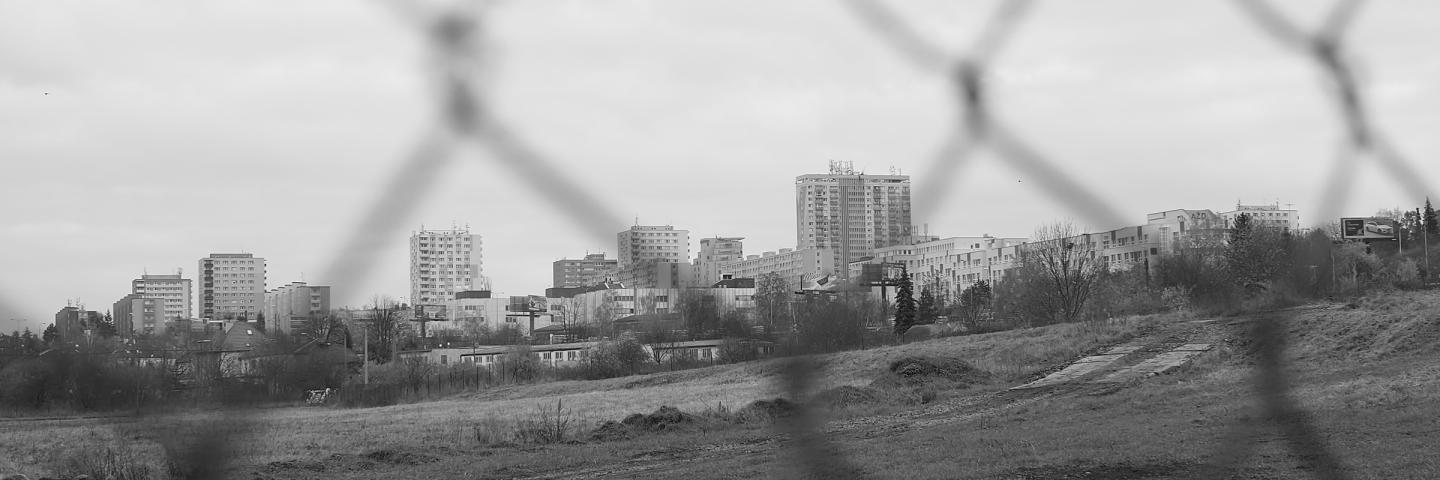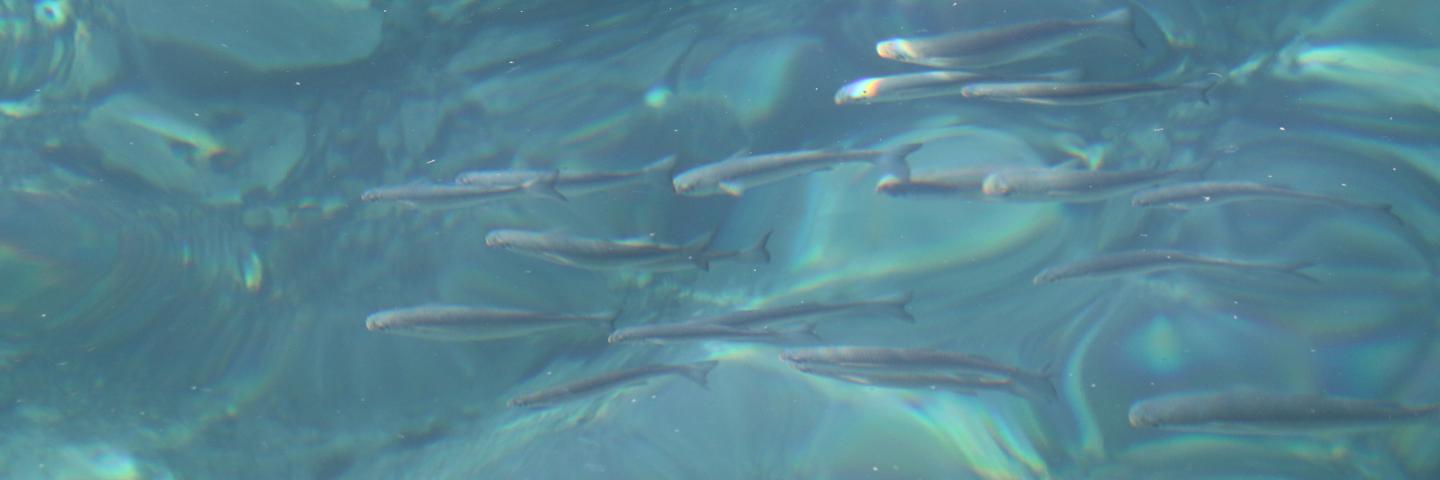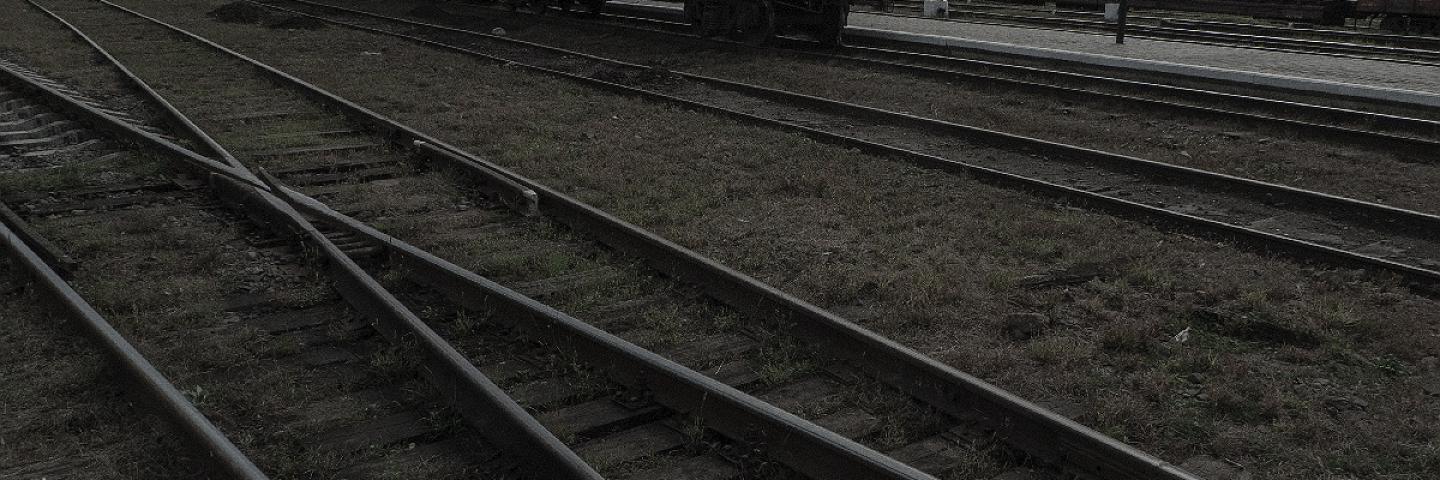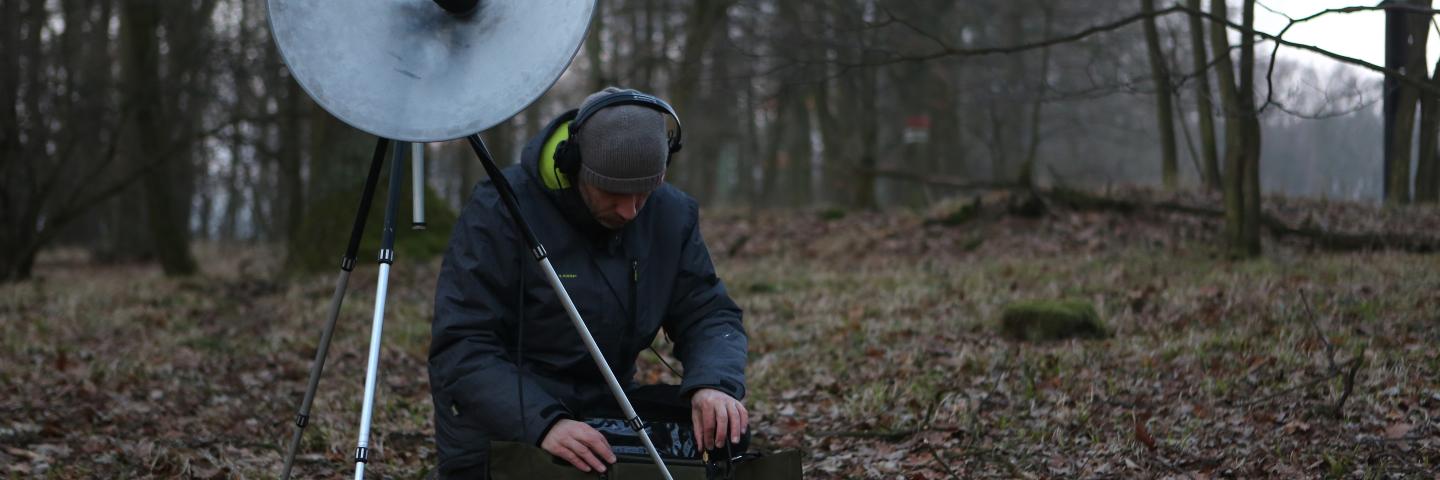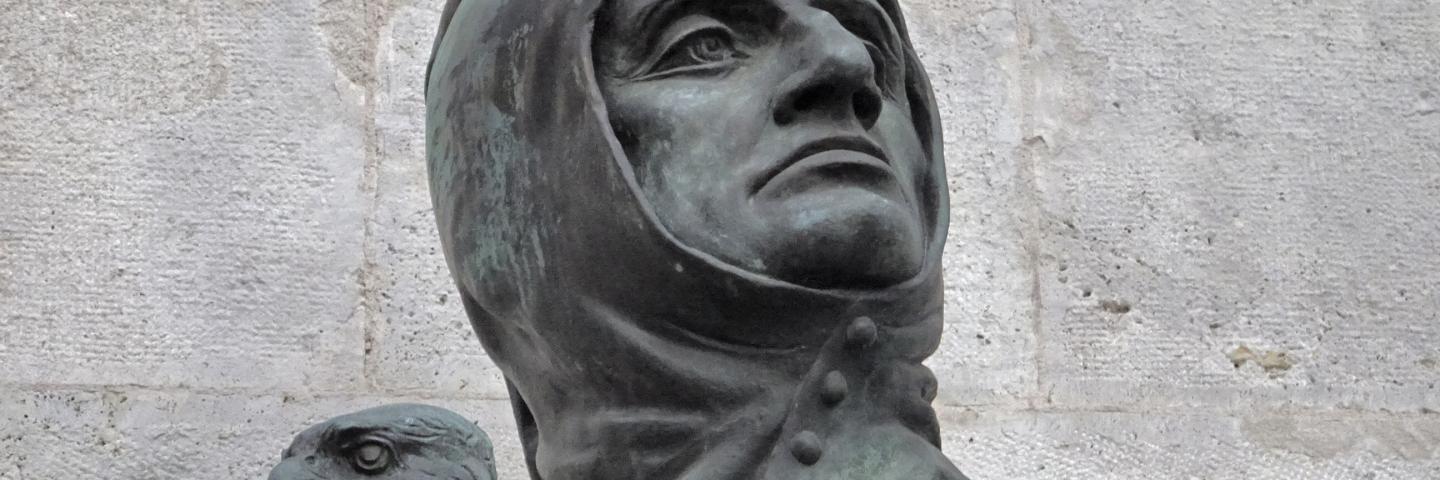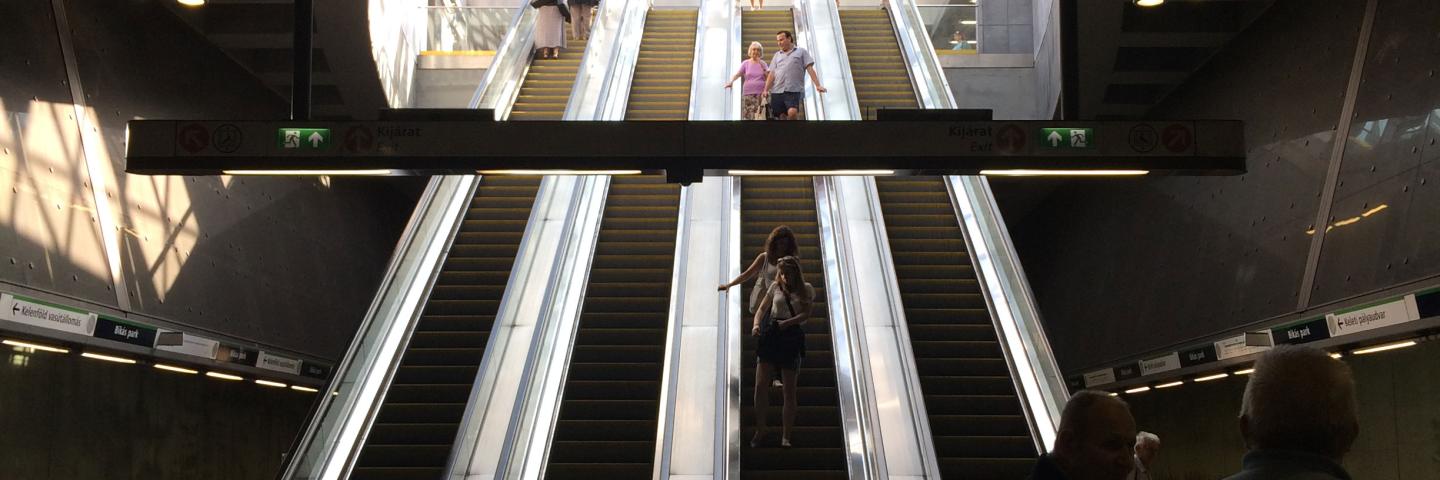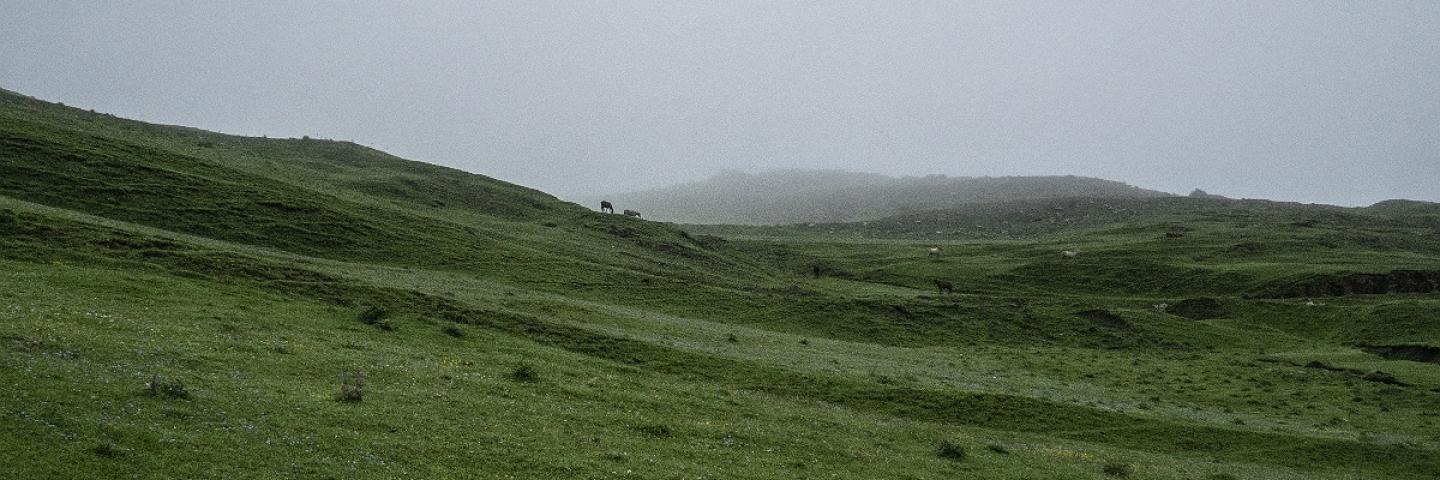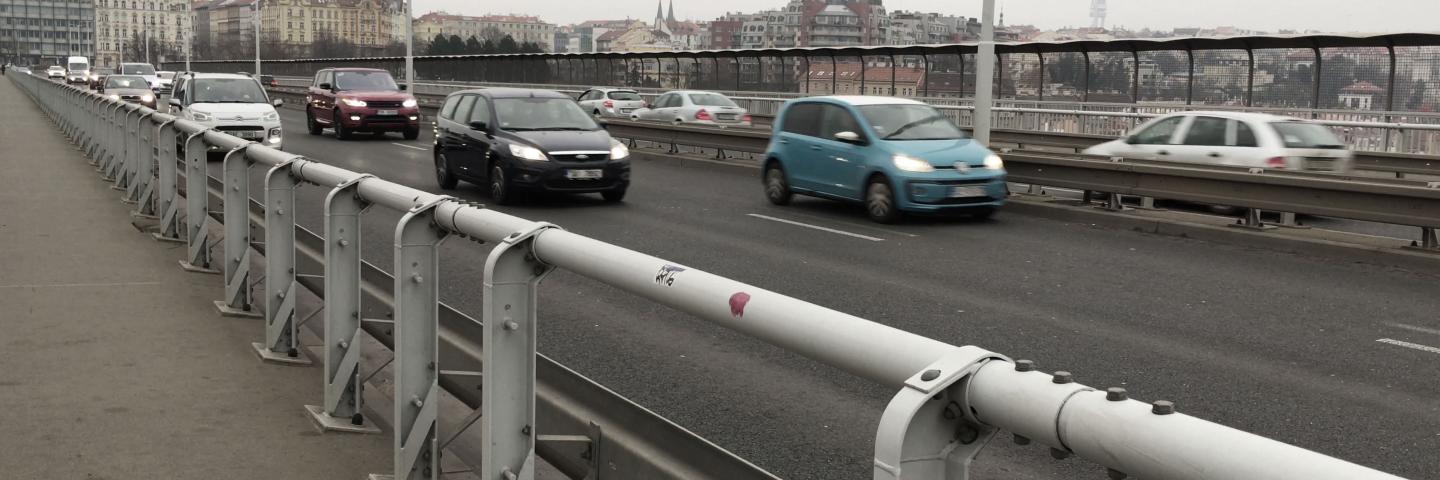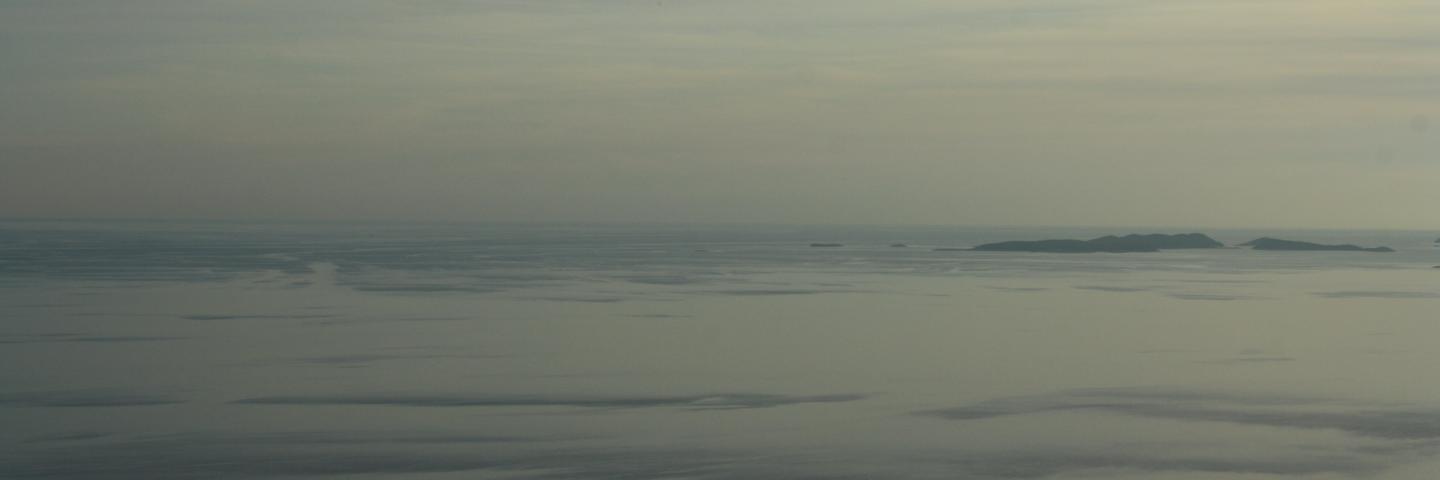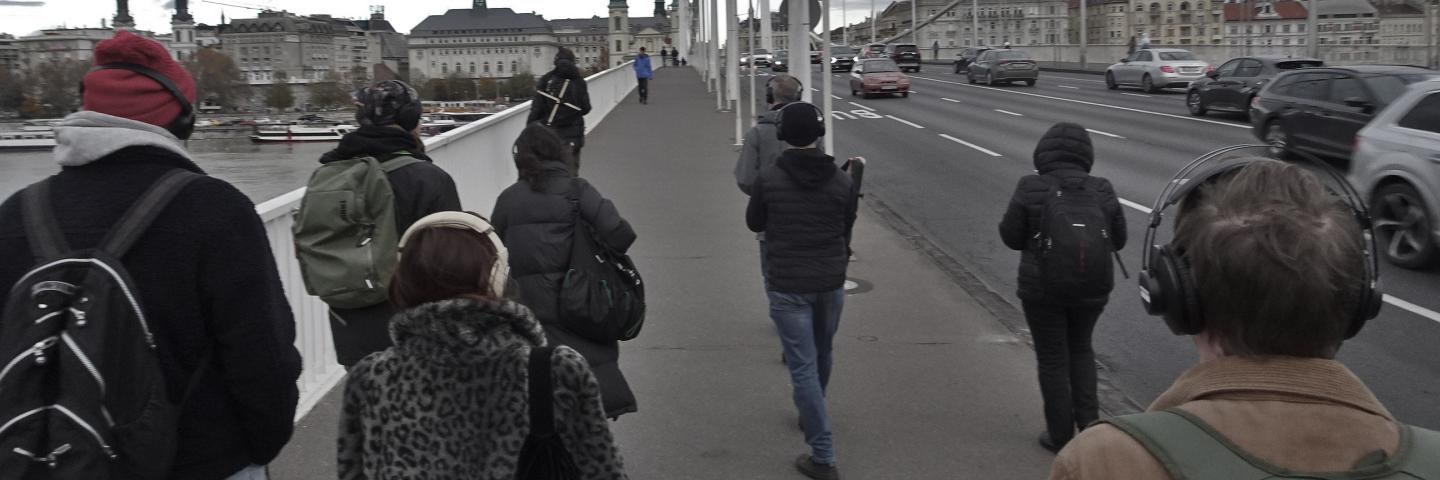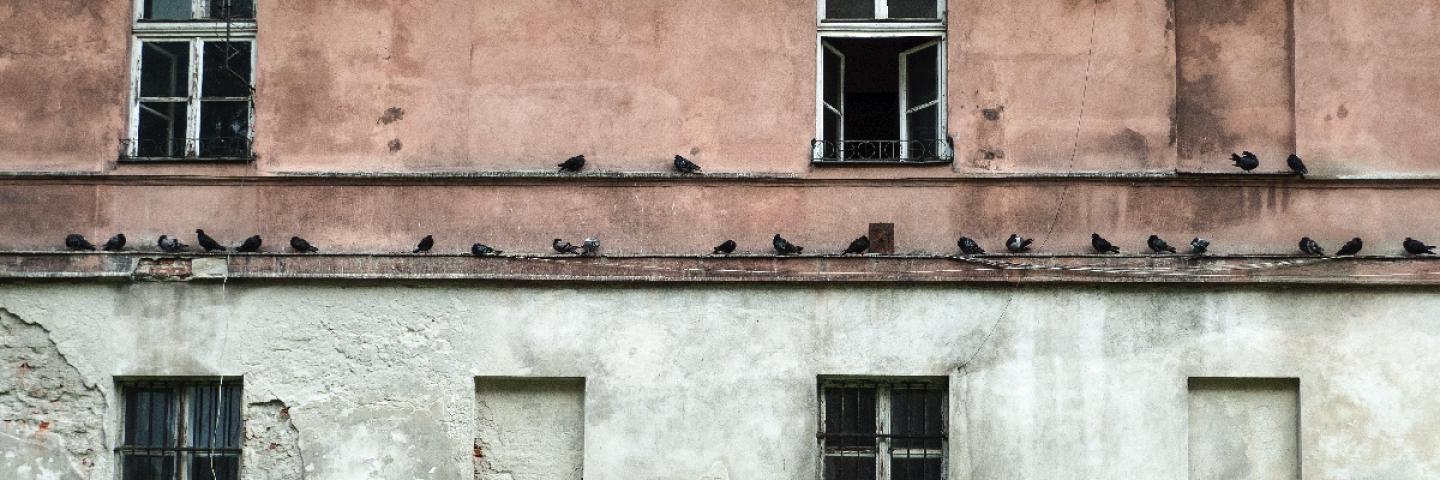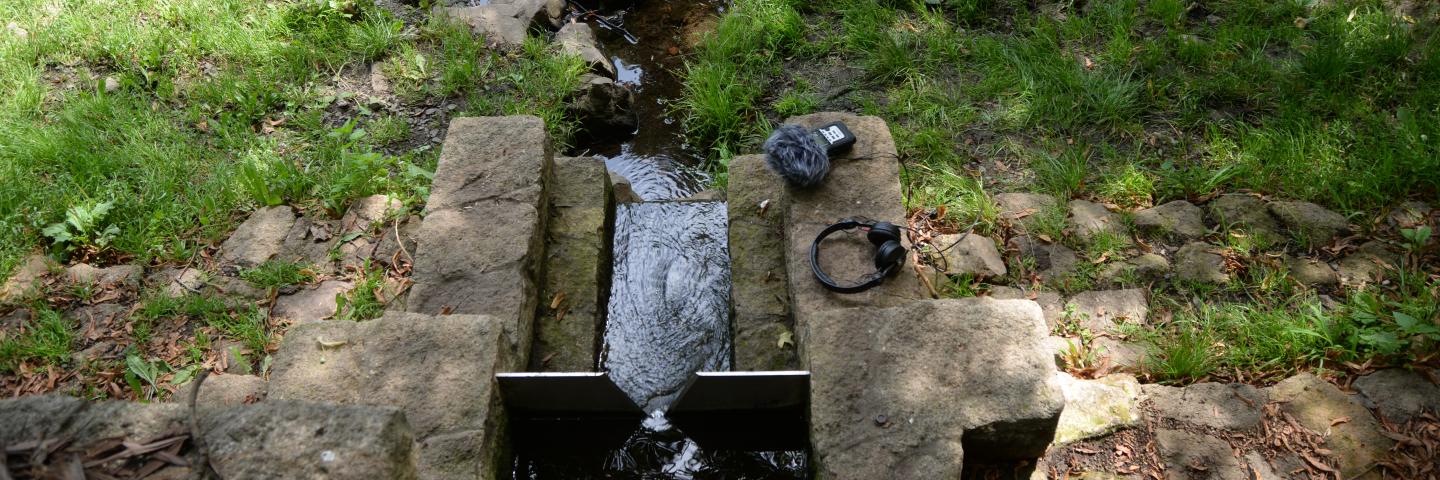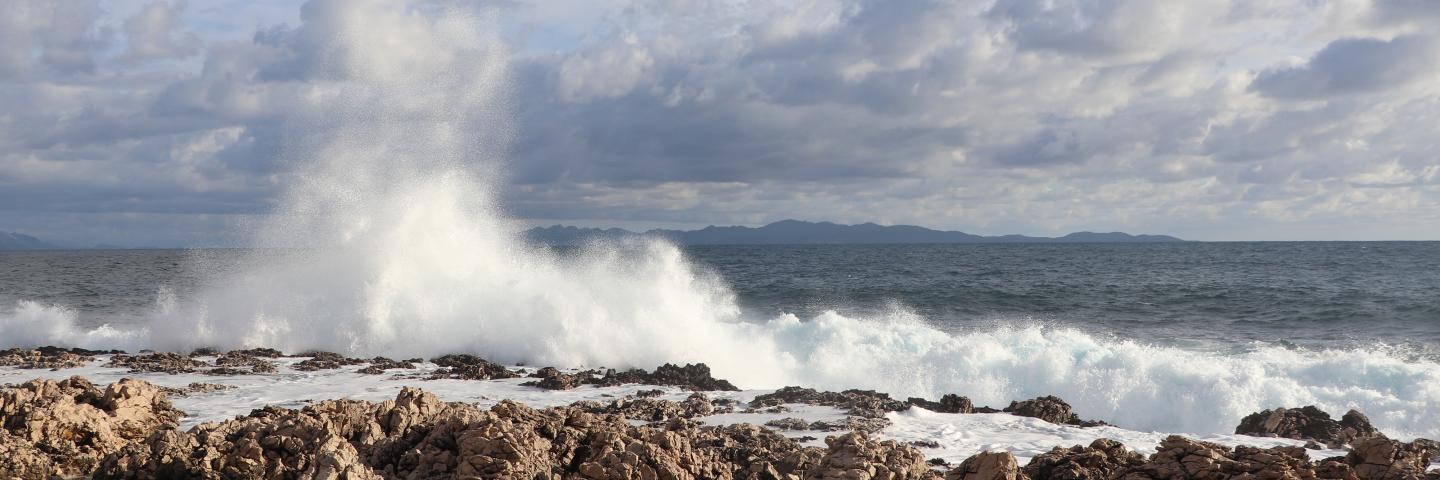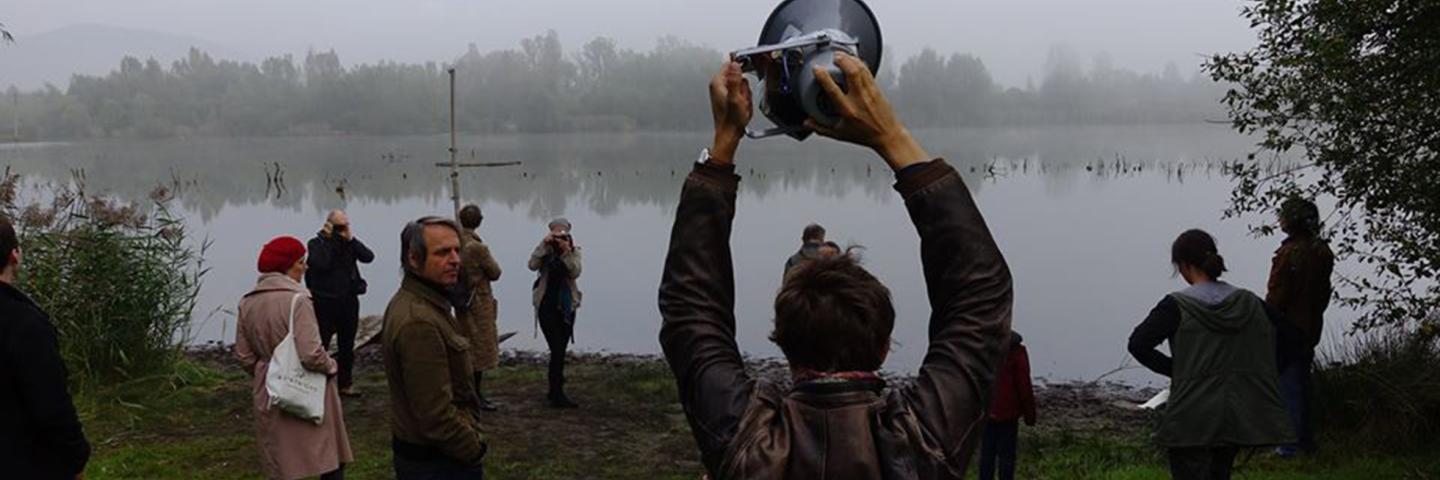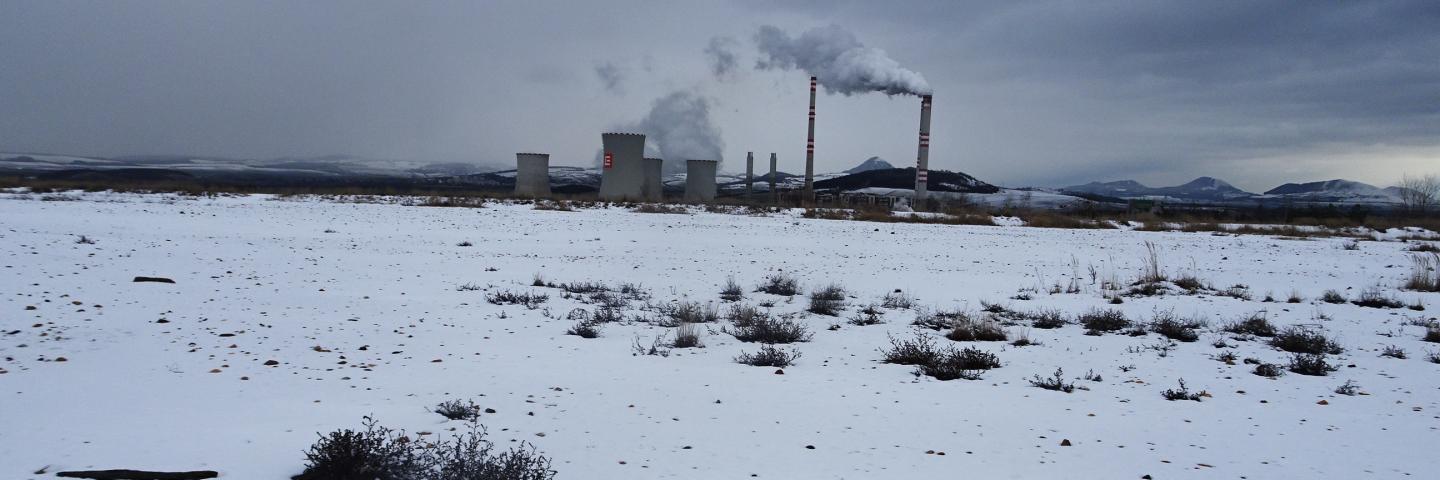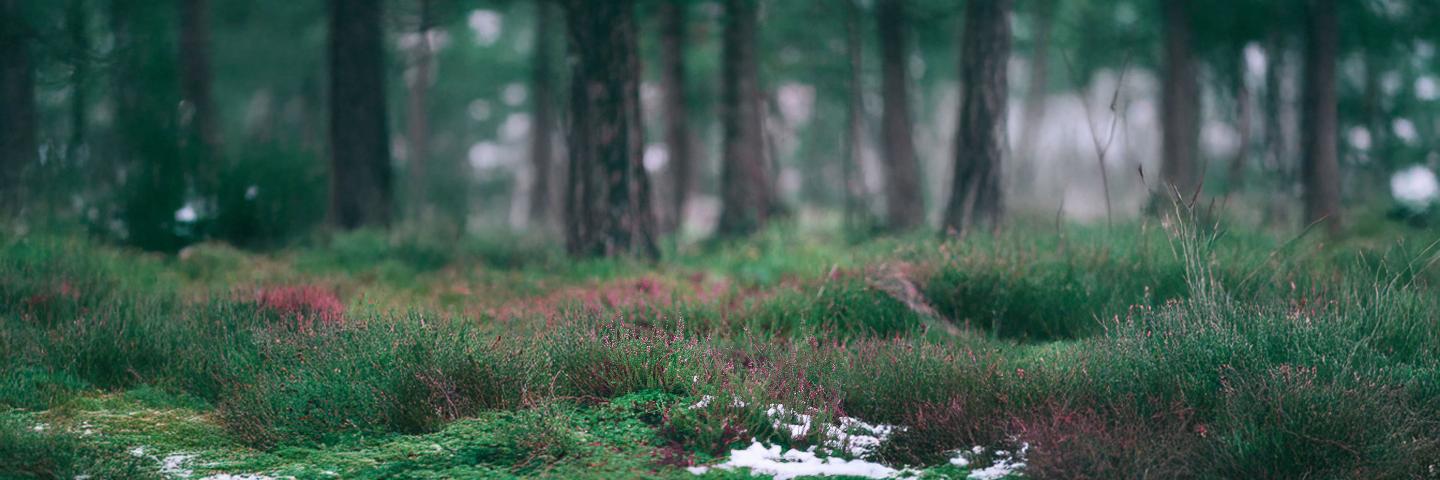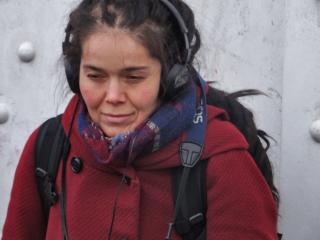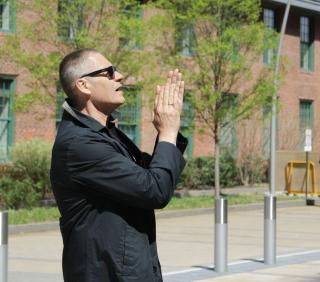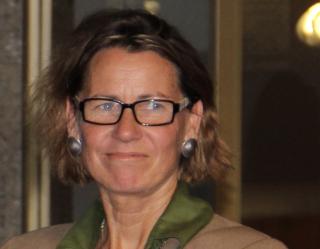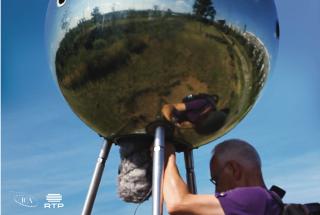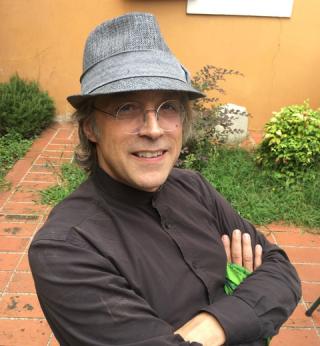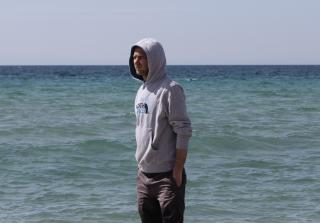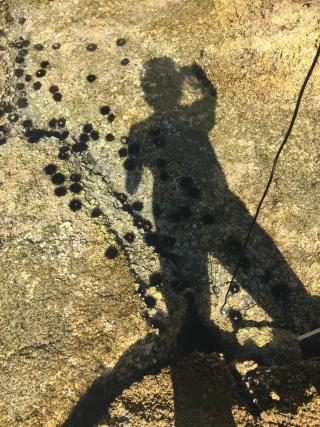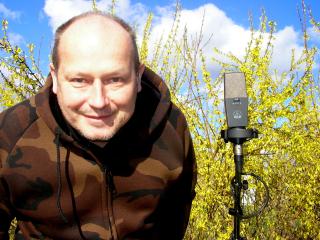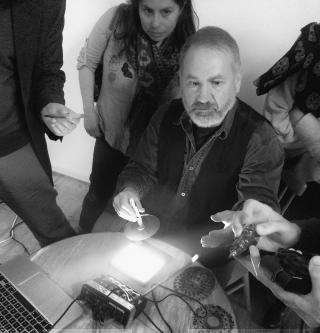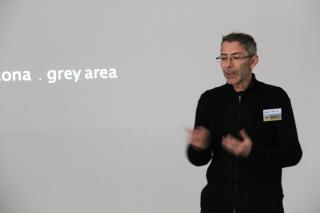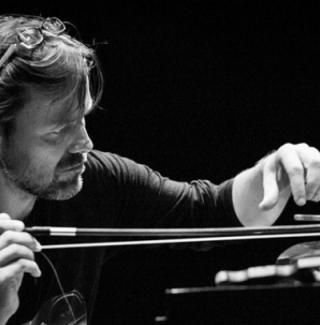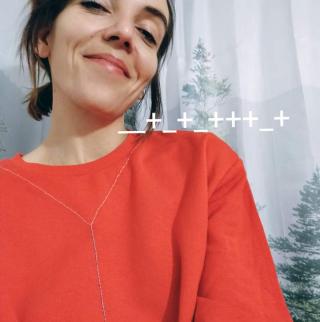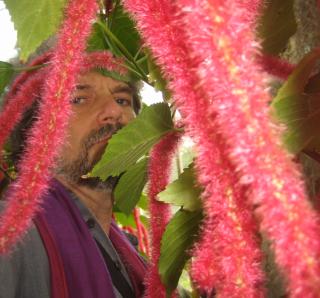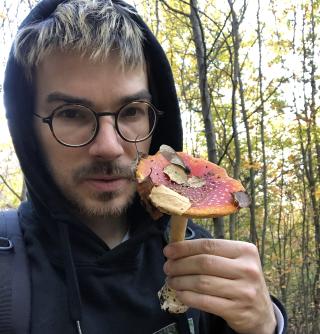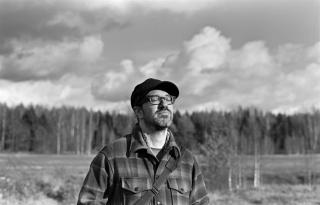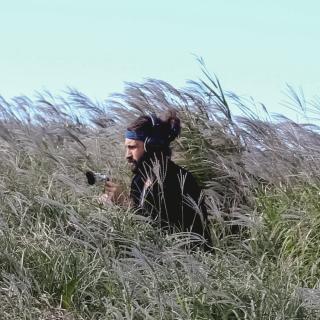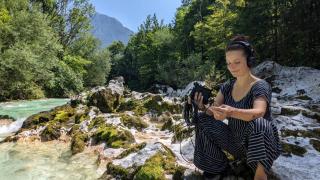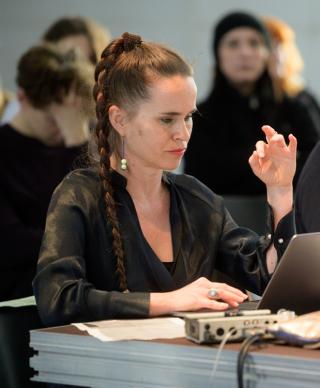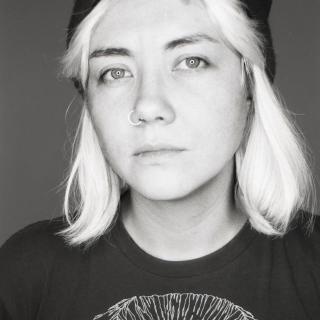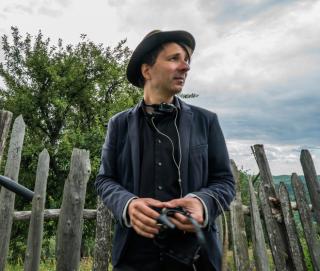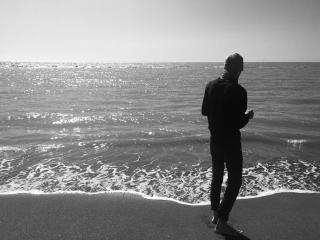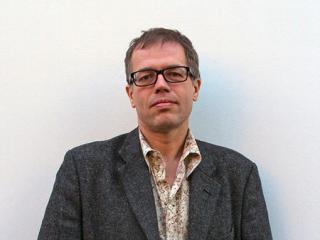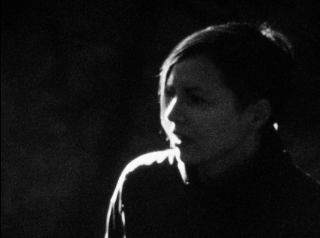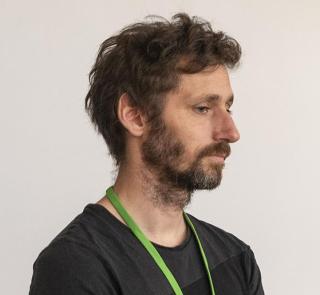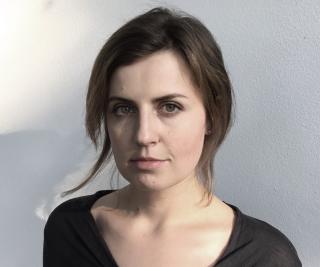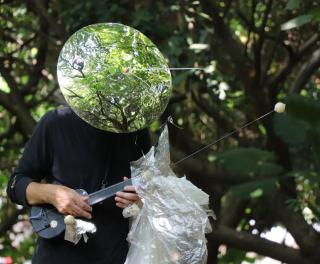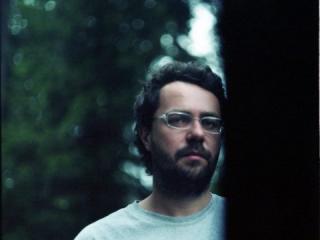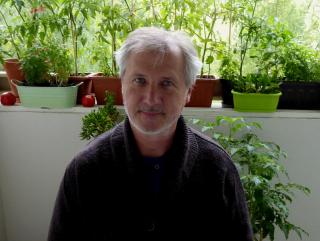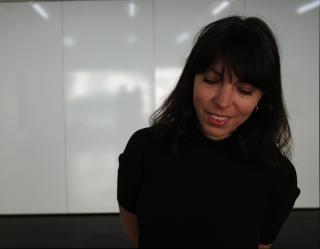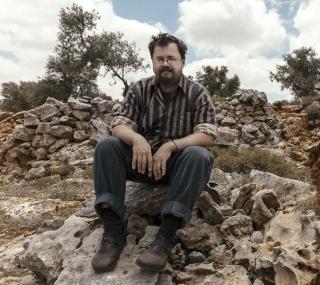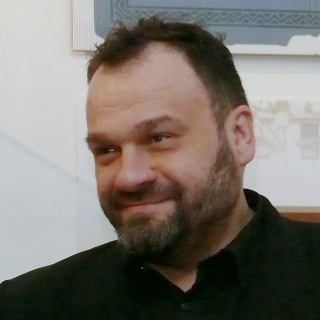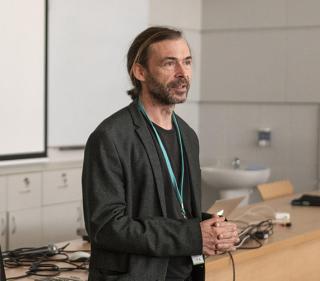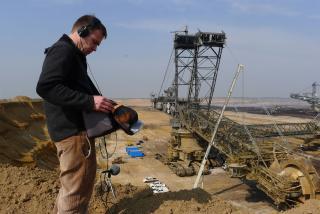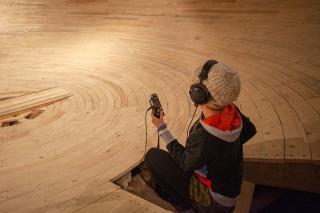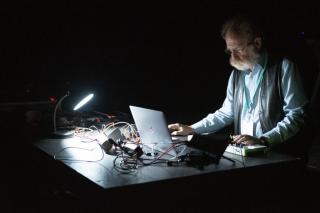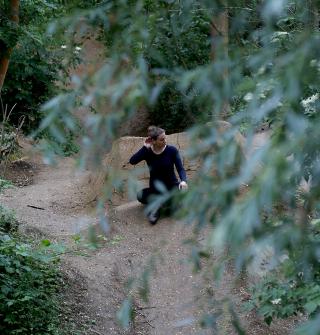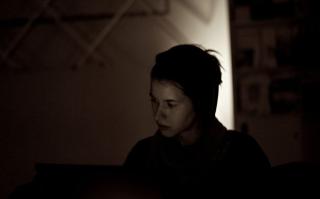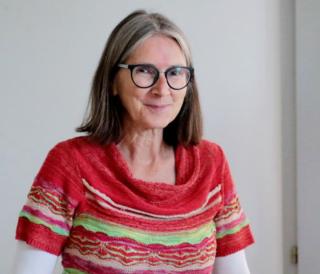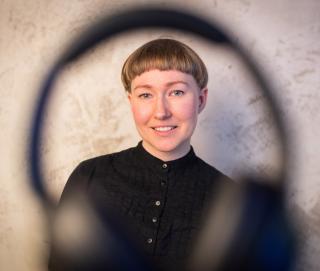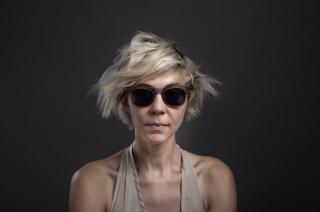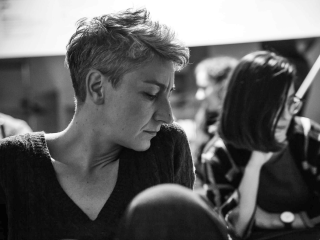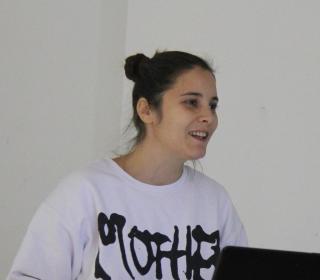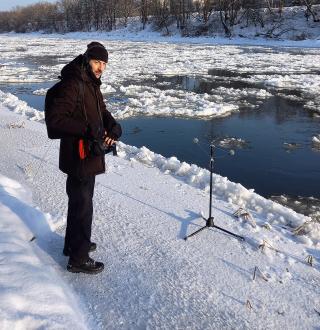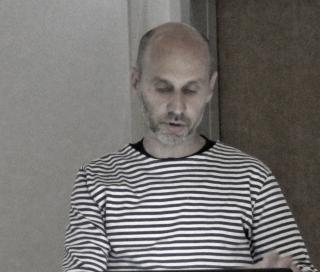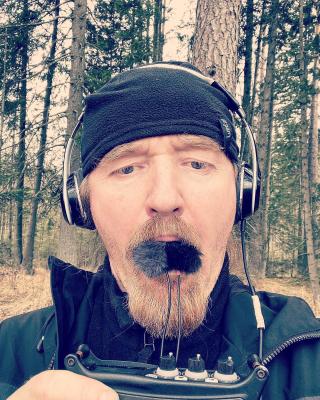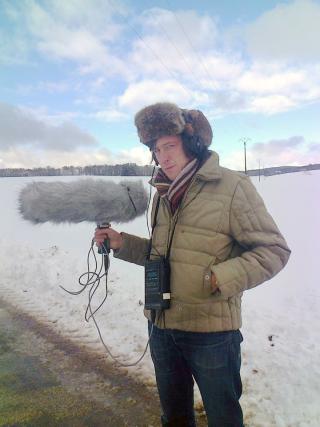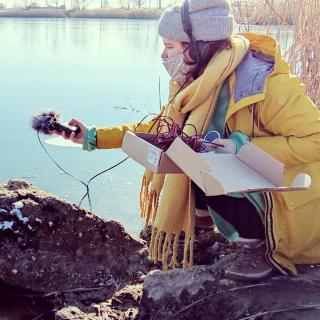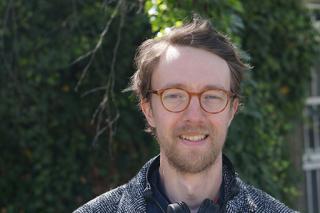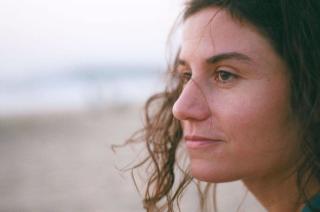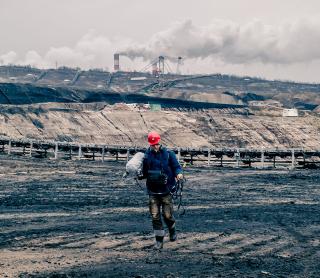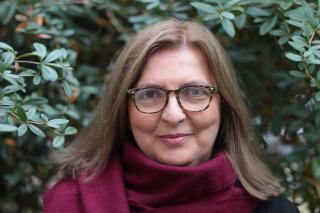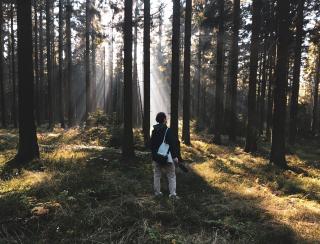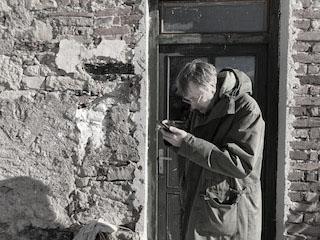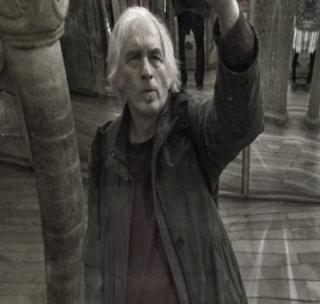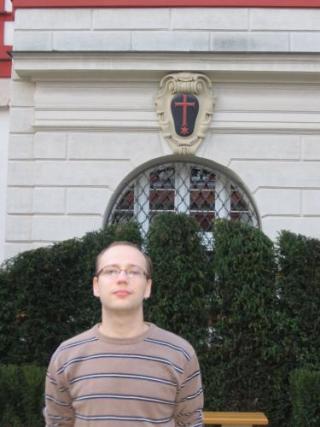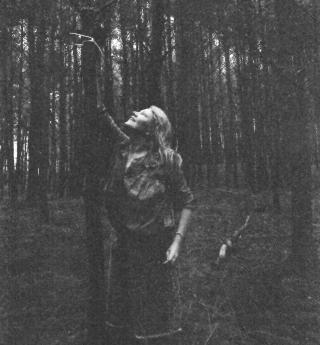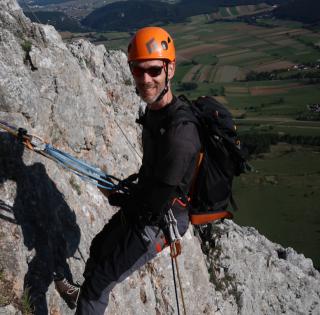Supporting Members
Maja Bjelica, PhD, is an associate researcher at the Science and Research Centre Koper’s Institute for Philosophical and Religious Studies, Slovenia. Currently she is working on the research programme on liminal spaces in areas of cultural and societal cohabitation in the age of risk and vulnerability, and a research project on saltmaking as experiential environmental wisdom. She obtained her doctoral degree at the Faculty of Humanities of the University of Primorska, Slovenia, with the dissertation “A Philosophical-anthropological Study of the Possibilities of the Ethics of Hospitality: Breath, Silence and Listening in Spaces of Intersubjectivity”.
She transdisciplinarily cross-pollinates research in themes of ethics of listening, ecoethnography, (applied) ethnomusicology, community music, environmental humanities.
She participated at the Beyond Listening Conference in Budapest 2023 and at the Festival (O)pot in Ljublana 2024.
maja bjelica: experiencing listening
Research Centre Koper’s Institute for Philosophical and Religious Studies
Sam Auinger (1956) is an Austrian sonic thinker, composer, and sound artist. Central to his artistic research aims to deepen understanding of acoustic/aural qualities in our urban living environments, precisely public spaces. He propagates "thinking with the ears." For him, it is a critical daily praxis towards understanding our role in an endangered planetary environment at all levels, from social to environmental. With Bruce Odland, he founded O+A in 1989. Their central theme is "hearing perspective." In 2009 O+A introduced the idea of the "Sonic Commons." It questions the dominance of the visual culture in our perception of the world. Sam Auinger was a professor at the University of the Arts in Berlin. He lectures and gives workshops at international Universities like GSD at Harvard, ACT at MIT, or London School of Architecture. He collaborates with city planners and architects and places a high value on a personal experience on-site in all design and planning processes. Sam participated in the Cense conference in Ústí nad Labem and Beyond listening in Budapest.
Barbara Benish (1958) is an artist, curator, writer and farmer. She moved from Los Angeles to Prague as a Fulbright scholar and stayed. Her artwork has been shown in hundreds of international exhibitions in Europe and the US. Benish is Founding Director of Art Dialogue, a Czech NGO which runs ArtMill, an eco-art center in the Czech countryside. She is a Fellow at the Social Practice Arts Research Center at University of California Santa Cruz, and an Advisor to the UN Safe Planet Campaign.
Opening this aural sense, as well as oral, tactile, and olfactory, is part of the physical experience that exposes our bodies to pain and pleasure, reconnecting them to the environment around us. In this way the traditional optical engagement of the visual arts is expanded to embrace a more vibrational, meta-physical experience. Perception is directly connected to political and social activity, to which my work is deeply committed as we navigate the end of the Anthropocene, and seek to repair human-induced violence against the Earth.
Peter Cusack is a field recordist, musician and sound artist with a long interest in the sound environment. He initiated the “Favourite Sounds Project” to discover what people find positive about their everyday sound environment and ‘Sounds from Dangerous Places’ (sonic journalism) that investigates sites of major environmental damage such as the Caspian Sea oil fields and the Chernobyl exclusion zone.
'He produced 'Vermilion Sounds' - the environmental sound program - for ResonanceFM Radio, was a lecturer/research fellow at the University of the Arts, London. In 2011/12 he was invited as a DAAD artist-in-residence in Berlin and began Berlin Sonic Places that examines relationships between soundscape and urban development.' His musical collaborators include David Toop, Steve Beresford, Terry Day, Clive Bell, Martyna Poznanska, Udo Noll, Max Eastley, Nic Collins and Viv Corringham. He is based in Berlin and London. Peter participated in the conference Mundus Murmurans in Ústí nad Labem and many other events in the Czech Republic since 1994.
Antonio Della Marina is a sound artist and curator based in Udine, in the northeast of Italy. He graduated from DAMS in Bologna with a specialization in music and is active in sound art through concerts, lectures, and sound installations. His work exploits the physical properties of sound and the use of microtonal tuning systems, mainly combining environmental acoustics and digitally generated sine waves. His works have been exhibited internationally in festivals and art galleries.
His works has been exhibited in art galleries and international festivals including Angelica Festival, Experimental Intermedia and Issue Project Room in New York, the Prague Quadriennal, the Logos Foundation in Ghent, Fundaciò Phonos in Barcelona, Lydgalleriet in Bergen.
In 2011, along with his partner Alessandra Zucchi, he founded Spazioersetti, a private exhibition venue based in Udine entirely dedicated to sound and architecture. Through their NPO Continuo, they curate and run projects on sound related practices.
Toni Dimitrov (1980) a multimedia artist, cultural producer, radio host, communicologist, organizer, curator, label owner, mountain/rock climber and nature lover, living in Skoplje, Macedonia. He connects all those with the love for music, sound art and field recordings. Working in the field of sound art and experimenting with electronic music and radio. Have been curving his way into the new experimental music/sound art scene with his solo engagement, collaborative releases, radio art and art installations. He is searching his own way of merging styles of music, such as ambient, soundscape, long-form drone explorations with pure field recordings. Through the years released of different releases under several monikers, collaborations and bands, having releases on diverse labels and performed on many events, locally and abroad at festivals, participated at several residencies. Currently curating labels post global recordings, élan vital recordings and took part in exhibition The Audiosphere, Sound Experimentation 1980 – 2020
Pablo Diserens (1994) is a field recordist, composer, filmmaker and visual artist based in Berlin who engages with various topo- and phonographies with a wide range of sonic and visual recording techniques. Blending a rich variety of located sounds with texts, analog photographs or video, Diserens' work brings the bio- and geological features of the explored environments to the foreground. By doing so, they propose narrative structures embedded in acousmatic forms and sonic ecology that aim at sparking environmental awareness.
Pablo Diserens is also the co-founder/curator of forms of minutiae, a publishing platform that supports a plurality of projects in the field of electroacoustic music, phonography, acoustic ecology and visual art.
Wolfgang Dorninger: (Born 1960 in Linz) Sound is the main focus of my artistic work, no matter as musician (The Smiling Buddhas, DORNINGER, Wipeout, ...), label-owner (base), sound-artist or lecturer at the Art University of Linz. Two diametrically opposite worlds of sound occupy my work oscillating inbetween musique concrète and digital sound-production in a range from sound-installations, multi-media-performances, music for theater or techno.
My working credo is: Sound Art before midnight, and Techno after midnight.
Lloyd Dunn or ( nula.cc ) is a founding member of the intermedia and experimental group the Tape-beatles, and editor and publisher of several small-press zines, such as PhotoStatic and Retrofuturism. Beginning in the 1980s, he has worked in a range of media, including 16mm film, video, audio, press, and works for the web. He studied linguistics and film and received an M.F.A. in art from the University of Iowa. Dunn is the author of the filecast project nula.cc, comprising hours of sound works, and hundreds of photographs, as well as texts, which often reflect his frequent travels. Individual ‘filecasts’ consist of assemblages of sound, images and words which are freely available for download. Since 2001, Dunn has lived and worked in Prague.
Darko Fritz / Gray Zone (1966) is artist, curator and researcher, living and working in Zagreb and Korčula. His work bridges over the gap between contemporary art, media art and network culture, taking up topics such as the glitch, error, and surveillance and uses different media as graphic art, photography, video, internet, etc. He is a critical observer of technology that changes the society, but he has also worked on a series of projects in which he used untypical media. His curatorial work and research on New Tendencies and early digital art has earned international acclaim with exhibitions at HDLU, Zagreb, Neue Galerie, Graz, ZKM, Karlsruhe and Akbank, Istanbul. He started the research “The beginning of digital arts in the Netherlands (1955 – 1980)”. Fritz is founder and programmer of the Grey Area – a space for contemporary and media art. Member of professional organizations HDLU (visual arts), ULUPUH (design), and AICA (art criticism).
Július Fujak (1966) is a scholar, a semiotician of music, experimental composer and multi-instrumentalist. Currently, he lectures at Department of Cultural Studies at the Faculty of Arts, Constantine the Philosopher in Nitra (since 2007). His compositions and intermedia projects were performed and broadcasted in many countries of Europe, USA, and China. He has organised for twenty years the international series and festivals of contemporary, unconventional music and intermedia art Hermes’ Ear in Nitra and PostmutArt.
Having just a joy & insight in sound: as unconventional composer/comproviser ocreating various musical-sonic situations (in field recordings including), and as semiotician/aesthetic scholar reflecting existentially semantic, cultural and socio-political dimensions of sonic environments.
Barbora Gallo (1984) is a curator, manager, fine arts teacher and artist living and working in Tbilisi, Georgia. She moved to Tbilisi in 2016 from Prague and has since become the curator and artistic director of the Georgian cultural NGO Public Art Platform a founder of Community Radio Tbilisi (January 2020) and an international radio platform Common Waves (October 2020). She has also participated in radio projects in Iceland (Community Radio Seyðisfjörður). Community Radio Tbilisi has so far broadcasted 300 unique shows involving local and international artists and musicians, participated on several international projects (Arts Birthday, Tbilisi Architecture Biennial, Performance Days Tbilisi).
I am generally interested in a radio as a medium transmitting the culture, social and environmental experiences and in experimenting with techniques of broadcasting.
Jeff Gburek (1963) is a sound artist, composer, instrument builder, field recordist & blogger, based in Poland. As a guitarist born in the USA, after studying gamelan music in Bali and Java, explored improvisation as percussionist, and built his own hybrid world music free noise junkyard percussion set with oscillators and shortwave radios. Over the course of the last few years, the works have been focused on soundscapes, horspiel, spoken-word, text, voice experiments, themes of ecology and climate change. He has had artistic residencies in Berlin, Lyon, Amsterdam (STEIM), Darmstadt, Brussels. Until the recent pandemic he's been a frequent traveler of Eastern Europe and the Balkans recording folk music and sonospheres, which he publishes primarily on his netlabel Akashic Records. Jeff attended the conference Mundus Murmurans in Ústí nad Labem.
Listening for what's crawling between the walls, looking for the unseen, reflecting on the accent of the unheard, the marginal, the innocent obscenity, going a few extra steps out of my way, wondering what that really means, enabling interfaces with the ineffable, abiding by the life of small things, learning from others, enjoying chaos, finding clues to how it all fits together, forcing nothing to be.
Jonas Gruska was born in Czechoslovakia and studied at the Institute of Sonology in Hague and at Music Academy in Cracow. His main focus is chaotic and polymetric rhythms, unconventional tunings, exploration of psychoacoustic properties of sound and field recording. He has created several site-specific sound installations, based on resonant properties of spaces and materials. Gave workshops on sonification, field recording, electromagnetic listening, and programming for artists. He is the creator of Elektrosluch – electromagnetic listening device.
Long–time field recordist and lecturer. Currently interested in contrasts of biophonic and antrophonic environements in the city
John Grzinich (1970, US/Estonia) has worked since the early 1990s as an artist and cultural coordinator with various practices combining sound, moving image, site-specificity, and collaborative social structures. He has performed and exhibited in North/South America, Europe and Japan and his compositions have been published on a host of international labels. The focus of his work in recent years has been to combine sound and listening practices with various media to challenge age old anthropocentric perceptions of the world we inhabit. He lives in Estonia and apart from his personal artistic practice, coordinates activities for the artist-run organization MoKS. He is currently a visiting Associate Professor of New Media in the Faculty of Fine Arts at the Estonian Academy of Arts and a visiting professor of Sound Design at RISEBA University in Riga.
What is field recording?
This is a question I’ve been asking myself ever since I realized that “field recording” was something of a viable genre for many working with sound. Before hearing the term “field recording” (and I’ll throw in Phonography), I never thought much in making a distinction between working in or out in the field. I recorded what I wanted and where I wanted (and still do). While some view it as a recording technique for any place other than the studio, others seem dedicated to the cause and strive to reach new levels of purity. The spectrum of approaches is wide from scientific ‘nature recording’, and commercial ‘relaxation environments’ (some may know the interesting ‘environments’ series from the 70s) to weekend hobbyists who simply like to get out and record sounds they like.
Yannick Dauby makes and important point in his description of “Field recording and phonography” as to why we who record sounds in the field are shaping the sound as much as we are simply capturing it: “The couple microphone/headphone acts as a filter and an enhancer for perception. The use of these tools is absolutely not neutral: the choices of the place and the moment, the gestures, the technical limitations and the zoom/macro effects of the microphone affect the result of the recording. The recordist makes a series of decisions in his practice, and these decisions are related to his own subjectivity.”
Numerous other in depth perspectives on the practice have emerged in recent years, I suspect due to the availability and ease of use of digital technology. People like Aaron Ximm Quiet American and Ernst Karel have been long term proponents of creative uses of field recordings and seem to have inspired many through their output. As the “field recording” bug spreads I suspect we may see ever more variations and mutations on what this is about. As for listening to field recordings it’s a fertile matter for another post.
Like any term, the definition is open to interpretation. The artist Jez Riley French has opened up the discussion with his ‘four questions series regarding sound artists/musicians and their use of “field recording” in their work. However, Jez seems to have moved his website and in the process, removed the four questions series, so I’ve reposted my answers below:
JrF: when & why did you become interested in field recording?
JG: If I really think about it, its hard to say. I’ve had access to tape recorders since I was a kid and I was always fascinated by the process of recording sounds and playing them back. There is something inherently moving in using recorded sound as a form of sensory feedback. While in high school I distinctly remember recording a thunderstorm on my boom box. Despite the awful quality I used to listen to that recording and reflect on what it was that made me want to preserve that natural experience. There was something different about trying to capture sonic events in the world outside of human control. In the beginning its usually about recording ones voice then trying to bang on things, to make “music”. But simply by recording yourself making noise that doesn’t always mean its “music”. Any produced sound is first a seed for some form of reflective activity and if the noise develops into a coherent form or simply even a reason continue the activity, then we might be looking at music which for me is more of a social phenomenon. I prefer to use the term ‘sound capturing’ rather than ‘field recording’ (which stems from a technical description rather than an instinctual activity), because of the ephemeral nature of sound and the need to include the element of human decision in the act of recording. So we have the ‘self’ and the ‘field’, or rather internal and external domains where a unique form of exchange happens via the medium of sound along with the technical means to mediate that exchange. The field is entered and one chooses to use one sense over another. Hearing becomes the tool for a deeper form of listening, the metaphor we know as a form of reflective thinking.
So the story continued that every time I had access to a portable recorder I was drawn to ‘the field’, to tunnels, forests, lakes, buildings, obsolete structures and areas of random debris. The field is an open system where sound cannot be controlled but rather explored and contributed to. Its the unkown elements, the small surprises and everyday discoveries that keep me going out and listening for more. I’ve always said about my compositions that the closer you listen, the more you will hear. But in fact that is my very approach to the sounding world in general. From the microscopic events of insect behavior to the cosmological planetary cycles, there is an endless field in which to play and hear.
JrF: how do you use your field recordings in your own artistic output?
JG: My recording of field activites have found their way into compositions in either treated or untreaded forms. I don’t believe in such a thing as ‘pure’ field recordings. Captured sounds are always colored by any number of factors such as microphone types, recording format, process of reproduction and then of course the end listeners situation. So I treat my ‘field recordings’ as source material like any other.
Lately I’ve started to document more of the recording process, the conditions and context of the location, with photos and video. There’s a hidden story behind every recording and by sharing aspects of the process other than the recording itself, clues are given to the audience. Good discussion about the various conditions under which recordings get made has been left out of the community of people working with sound, yet with more open forms of sharing, more distict interest in artistic practices are emerging. My hope is that additional angles on our processes, such as my ‘location sound films’, will help open up some topics on what it is we’re doing and why.
JrF: Has the act of making field recording an effect (positive or negative) on the way you listen to your everyday surroundings and how has it affected the way you listen to other music and sound (if at all)?
JG: The trained ear can easily see the world as a constantly changing composition. I’ve become more sensitive to the sounds around me. With this I recognize sound as some sort of political force that can significantly shape the world around us. I ended up moving to the countryside partly because of this, to choose what kind world I want to hear and to have access to the open terrain I enjoy exploring. Since becoming a more active sound artist I haven’t bought much music which may have been another side affect. I really enjoy trading materials with other artists, and to have more direct contact for exchanging ideas.
JrF: For me, the aspect of discussion about the process is usually more to do with the technical side of things & I have always found that the least interesting – the realm of those who perhaps often value the process (in terms of thier ability to influence it) more than the result. On the other hand I also feel that when recordings are created as something other than mere documentation – so in terms of music or art, then certain aspects of the process probably need to be private. For example I only create when I feel an istinctive emotive response & I do that through music / sound because that is the way I feel most able to communicate – if I tried to then explain the conditions in another way I might get so far but I don’t think for me that that will work too well. I often find it interesting to discuss motivations with people & also to get to ‘know’ them a bit often has an effect on how one can appreciate certain aspects of their work (or it can of course have a negative effect too !).
To add one to the set of the standard questions in this series, can I ask:
JrF: Do you feel there could be a danger that having a focus on the need or wish to discuss or explain could also serve to place a theoretical or practical barrier on this area of creativity – as it indeed can anything?
JG: In my experience good discussion on sound art/listening has always helped remove barriers between practitioners and and also listeners. There is a lack of linguistic means to express the aural experiences (at least in English) in comparison to the visual and tactile senses. We have whole cultures built up around taste and culinary delights, visual aesthetics, even perfumes for smell, but when it comes to sound in a more abstract sense we have little to go on once you go beyond the established genres of ”music” culture. Of course there is that intangibility of sound as a medium which causes our understanding of it to fall into the fringes of other disciplines. For example sound in art is tied to sculpture or installation “soundtracks”, in music it drifts into the gray are of being”experimental”, in architecture its left to acoustic engineering, in film its foley work or sound design. In each case sound is a side effect of the primary field or medium. I suspect its this “side effect” status of sound that waters down our ability to articulate aural experiences and hence for artists to describe what they do with sound and why. I agree that the need for an explanation, as you have implied, can easily over run the experience itself, but this is the case with almost any art form. We’ve all met students who have been forced to read so much theory, they never want to look at another painting or hear a piece of music again. That’s not what I’m referring to. I’m talking about discussion that enhances our direct experiences and abilities of working with sound in ways that respect the personal introspective nature of listening and creation in as much as it broadens its potential as a valid non-linguistic means of communication. Transforming sound experiences into words is not easy or always immediate. It takes time. But the overall effect seems to be deeper, more permanent, and potentially more useful when filtering through this great ‘noise’ we call life.
JrF: Yes, I can see your point there of course. I prefer that we don’t always try to explain & I consider it would be much better if our understanding was based more on naturally developed instincts. I see the benefits from discussion, especially on a personal scale, but I find that the wider, institutional or ‘scene’ expectations of being able to supply the theory to accompany ones work can often be oppressive and come across as rather elitist.
(re-published from)
Csaba Hajnóczy (1957) is a musician, composer, musicologist, and teacher at Moholy-Nagy University of Art and Design Budapest, living and working in Budapest. He was the main initiator and organizer of the CESSE – Conference #1. His recent artistic interest is field recording based composition and the use of spatial sound systems. Since 2013 he has given numerous talks and workshops in the field of acoustic ecology, including soundwalks, in Hungary, Poland, Belgium, Turkey. Csaba participated in the Architecture and Senses in Plasy, 2017 and in all following CENSE events.
I see it as a possibility to develop projects and interactions among individuals, associations and universities in the region to make it part of the worldwide flow of the ecology of sound and related art.
Mat Eric Hart, born 1988 in London, is an artist, composer, producer and sound recordist currently based in Provence, France. His work explores the territories of field recording, soundscape composition, sound design and sonic art through the medium of audio-naturalism - a practice deeply rooted in listening and connecting with the natural world. His journey on this path began as a volunteer at The British Library Sound Archive, immersing himself in listening to the vast database of sound recordings kept there. Working closely with the World & Traditional Music and Wildlife & Environmental Sounds collections and curators, he produced the soundscape installation for the public exhibition "Buddhism" (Oct 2019 - Feb 2020) held in The British Library's PACCAR Gallery. This experience inspired him to begin working on his own field project, which would become "The Mat Eric Hart Japan Collection". Published by The British Library in May 2021, the collection explores the relationship between sound and spirituality in Japanese culture, documenting cultural practices, rituals and performances through observing, studying and recording interactions with Japanese artists, traditional musics, festivals, natural environments and sacred spaces. Since relocating to France in 2019, he has committed himself to further exploring and developing his practice in his new environment. He has a close, creative working relationship with the radiophonic arts association Phonurgia Nova, with whom he has organised a series of well-received field recording workshops. He is the curator and producer of "Planète Hypnotique" - a quarterly radio transmission and open call platform commissioned by Chilean arts radio station "Radio Tsonami" exploring acoustic ecology, electro-acoustic and acousmatic works, field recording and soundscape composition.
"Profoundly inspired by the art of listening and the importance of being aware, mindful and understanding of the sonic spaces surrounding us. In searching for the point of recording, I find myself always in search for the spirit of the place."
Ida Hiršenfelder is a sound artist and archivist from Ljubljana. She performs under an onomatopoeic alias beepblip. She was employed at the +MSUM, Museum of Contemporary Art Metelkova on projects related to digital archives (2014–2021). She was a member of the Theremidi Orchestra (2011–2017), a DIY sound collective and is a member of the Jata C group that researches bioacoustics and sound ecologies. In the last years, she contributed to the Soundcamp programme. Her solo albums Noise for Strings, Vol. 1 (2019) and Noise for Strings, Vol. 2 (2020) were published by Kamizdat label. She currently studies Masters of Sonology at the Royal Conservatoire in The Hague.
I trace environmental processes and make immersive bleepy psychogeographical soundscapes to tell a sonic story. I use many layers and sound spatialisation to nurture an empathic and sensitive relationship for the environment in the hope of rewilded ecological restoration. (photo: Sean McIntyre)
Petra Kapš alias OR poiesis (1975) weaves her work among the arts of sound, radio, chrono-spatial poetry, poetic performance, books and reflection. Aside from the ethereal features of sound, she focuses on the physical presence of the body. She extends the word, her core medium, with sonic spheres of sonorous poetry. Kapš is interested in aural memory and the deep time of the body. Incorporating an (a)syntemporal presence through the digital sphere, she researches the possibilities of intimate radio and is concerned with the void ear of the internet listener. Her sound/radio/book works are located solitudes. Petra participated in the Soundworms gathering, Architecture and Senses, in the Cesse, conference in Budapest, and Second life of Recorded Sounds conference in Wroclaw 2020, Beyond Listening symposium in Budapest 2023 and Opot festival in Ljublana, 2024.
My main axis spins around modalities of silence and the aural / vibrational / resonant conditions of the planet and its matter / substances. We have bodies and with them the most magnificent sensory organism - the only one we truly possess but severely neglect to rely on the processed data. My concerns are intertwined with the anthropogenic noise, with its virtual-augmented aspects, and the concrete ones, generated by the infrastructure that is deeply embracing the crust of the earth. Regarding global warming and human narcissistic pathological behaviour / actions I would like to promote attuned listening. In my artistic practice I try to develop ways to attune with entities that surround me.
Polina Khatsenka is a new media artist from Belarus. Dominant part of her artworks is based on a wide variety of aspects of sound, such as sonic environment, field-recordings, electroacoustic music and spatial sound. Living and studying arts in Usti nad Labem, she fostered the knowledge in the field of multichannel audio formats and electronic music during a study exchange at Media and Design Faculties at University of Applied Sciences in Düsseldorf in 2018. Polina is currently getting her Master’s degree at Faculty of Art and Design, Time-based media studio, Jan Evangelista Purkyně University, Czech Republic.
Michal Kindernay (1978) is an intermedia artist, curator and performer, working and living in Prague. His audio-visual installations interconnect visual art, cinema, technology and science, reflecting ecological issues through various technological approaches in relation to nature environment. His works include audiovisual performances, interactive installations or experimental documentary or music compositions. He is one of the founders of non profit organization yo-yo and the initiator or RurArtMap project. He was one of the curators of Školská28 gallery in Prague. He works for the Agosto Foundation, teaches in Prague College and was teaching in Centre of Audiovisual Studies in Film and TV School of Academy of Performing Arts. As an organizer or artist he was involved in many international projects and participated in all CENSE conferences since 2018.
Bálint János Kiss is an acoustic communication designer living and working in Helsinki, Finland. He is dedicated to explore and create acoustic profiles following up-to-date scientific and artistic discourse on sound.
I have been intrigued by sounds since the early years of my childhood. I grew up singing, playing the piano and the cello. I was drawn to electronic music and sound design in high school and ever since I have always worked on sound and music-related projects. Before moving to Finland, I discovered acoustic ecology that had a huge impact on how I approach the current challenges of design – human-centric, ecological, and funcionalistic narratives became a very important part of my practice. I'm proud to be member of CENSE. In the last few years I worked on contemporary dance projects, different sound design tasks, and electronic music projects. Recently I've been working on podcasts, soundscape compositions, 8-channel compositions, and ecosound-related events and activities. In the past I was singer/songwriter of SwimmingBirds and singer/music producer of pill Vax.
I think that a collective aural awareness would mean the birth of a collective need for a sonically more authentic, caring, and aesthecially pleasing world. Beside the important work put in research and art I find it essential to involve and inspire people and communities in this matter.
Boris Klepal (1966) is a journalist and music writer, interested in music and in sound itself. Klepal is a regular correspondent of a music journal HIS Voice, Economic Newspaper (Hospodářské noviny) and portal Aktualne.cz. Since January 2020 he works as an editor in chief of musicological revue Opus musicum. He is open to add a new topics to Opus musicum and one of them is an acoustic ecology (or soundscape studies). Visit the Soundcloud link for his field recordings. Also link to his radio show about sounds of Brno and their influence on Leoš Janáček (created with Miloš Štědroň).
If you want to know the state of the world, you should listen carefully. The sound delivers the most fleeting and accurate news.
Alena Koroleva is a multi-disciplinary Russian artist who makes sound collages with field recordings. She also works in photo and video art and curates programs for film festivals. She has a degree in documentary filmmaking and has made a few short films, but since 2018 she's reinvented her practice with sound art.
I'm fascinated by the potential of accidental or routine sounds made by people, machines and animals to create music, by the ability of sound to change its power and meaning when put in concert with others. I find inspiration in exploring the soundscapes of big cities, finding rhythms in chance encounters, using incompatible fragments to create a tune. As a deep listening believer I perceive soundscapes as ever changing endless concerts which all living beings contribute to.
Jan Krtička (1979) is an audiovisual artist and teacher. In his work, he often works with elements of aurality, concepts and topography. Krtička graduated in sculpture at the Faculty of Visual Arts at the Technical Univerisity in Brno. His doctoral thesis (from the Faculty of Art and Design at the University of Jan Evangelista Purkyně in Ústí nad Labem) focused on theories and critical aspects of documentation in art. Krtička is interested in the context of landscape and often engages with the contingency of nature and the determinancy of the human. He was together with Pavel Mrkus the main initiator and organizer of the conference Mundus Murmurans dedicated to Acoustic Ecology in Ústí nad Labem.
Anna Kvíčalová (1986) is a historian of science, religion and the senses. She studied in Brno, Amsterdam and Berlin; between 2013 and 2017 she was a member of the research group Epistemes of Modern Acoustics at the Max Planck Institute for the History of Science in Berlin. She is the author of Listening and Knowledge in Reformation Europe (Palgrave, 2019) and other texts on sound, hearing and acoustics. Currently she is the leader of the research project The Second Sense: Sound, Hearing and Nature in Czech Modernity at the Centre for Theoretical Study (Charles University & the Czech Academy of Sciences) in Prague.
Historical articulations of aurality show us the listener emerging from complex relations with the resonating, ever-changing world. Thinking with sound in arts and sciences may contribute creatively to exploring, permeating, and redrawing the modern boundaries between the human and the non-human, culture and nature, or subjects and objects, the boundaries we have come to see as fixed.
Slavek Kwi (born in Czechoslovakia, lives in Ireland) is a soundartist, composer and researcher interested in the phenomena of perception. He has a longstanding fascination with sound-environments, that oscillate between sound and interdisciplinarity. His audio-based situations are created mainly from site specific recordings, resulting in subjective reports for radio broadcast, ‘cinema for ears’ for multi-channel playback, sound installations integrated into the environment and performances. From the early nineties he has operated under the nick Artificial Memory Trace. He facilitates experimental sound workshops with autistic children and those with learning disabilities, he emphasises extensive listening and the stimulation of creativity through observation and the support of natural tendencies.
I am perpetually tuning in any given sound situation, looking perpetually for balance of energy in between I (as singular entity) and “the other” (as multiplicity, everything else). Is this symbolical for practical applications?
Gerard Lebik (1980) is a improviser, sound artist, composer and curator, living in Wroclaw. He explores different sources and research methods on audible and percepcion field, focuses on such phenomenas as time, space, and sound waves. Lebik intrests genres and issues such as electroacoustics, noise, sine waves, binaural sound, radio art, post-conceptualism, and sonic relation in architecture and urban context. In 2007 graduated with Wroclaw Academy of Music. Since 2015 artistic director and curator in Sanatorium Of Sound – festival exploring experimental and new music held in Sokołowsko, near the Czech Polish border.
Peter Machajdik (1961) is a composer and a multimedia artist, living and working in Berlin and Bratislava. He is a founding member of the intermedia and experimental group Transmusic Comp. Since 2012, he has been Artistic Advisor and Trustee for the Sound City festival in Košice and the Music at Fulla new music concert series.
The main theme of most of my works is the environment, and I am often referring to the pollution of air and waters, as well as to the human-caused climate change in general: In my installation Waters and Cages, involving the visual and auditory realms, four cages include bowls filled with water from some of the most polluted rivers of the world, including the Yangtze, Mekong, Salween, Ganges, Indus, Danube, La Plata, Rio Grande and the Nile, hang in the exhibition room. The cages symbolise the changes in the organic components of the ecosystem, especially the risks to faunal assemblages, but also the changes in the inorganic components of the environment. They deal with the question of extinction of animal species, especially birds, mainly as a result of ecological degradation. The cage stands as a representation of the diminution of bird species, as well as drawing attention to the suppression of human rights and the imprisonment of many political activists in different parts of the world.
Magdaléna Manderlová (1991) is an artist, musician and composer. In recent years, she abandoned the visual media of painting and drawing, and works mainly with sound. In her artistic practice, Magdaléna works with listening as a tool to engage with the world. Through sound and listening, she pays attention to and communicates with a specific environment, and all the living creatures inhabiting these environments. Her works often take the form of site-specific sound installations, performances, artist books and texts, sonic essays and compositions. She graduated in the master's program in the painting department at the Faculty of Arts of the University of Ostrava, and in the international master's program at Trondheim Academy of Fine Art, NTNU. In the past she performed as a singer-songwriter moin moin and was part of the Czech independent music scene. Nowadays, she performs in the context of experimental music. Magdalena lives and works in Trondheim, Norway.
Patrick Tubin McGinley (1975, USA/Estonia), AKA murmer, is a composer and artist working with sound, site, radio, film, and performance. Since the mid-1990’s he has built a collection of found sounds and found objects that have become the basis of his work, along with techniques of site-specific sonic intervention and interaction. In 2002 he founded framework radio, and since then has produced a weekly field recording-focused radio show heard around the world. He gives presentations, workshops, and performances based on the exploration of site-specific sound with his ongoing Echo Surveys project, while in performance his interest in field recording has expanded into an attempt to integrate and resonate found sounds, found objects, specific spaces, and moments in time, in order to create a direct and visceral link with an audience and location.
My work is about small discoveries and concentrated attention; focusing on the framing of sounds which normally pass through our ears unnoticed and unremarked, but which out of context become unrecognisable, alien and extraordinary: crackling charcoal, a squeaking escalator, a buzzing insect, or one’s own breath.
Zoltán Mizsei graduated from the Franz Liszt Academy of Music as a professor of choral conducting and Church music. He received his DLA in 2004. Currently, he is associate professor there at the department of Church music. He teaches Renaissance church music, choral conducting and voice teaching practices. Since 2014 he has been the conductor of Schola Academica choir. He sings and plays instruments in several early music and world music ensembles, composes music for contemporary dance performances and films. He teaches improvisation for music therapists at ELTE University. He organized different festivals and workshops to combine composed music and soundscape. Recently has established the Music Laboratory at the Institute of Advanced Studies, Kőszeg (iASK) with an interdisciplinary research, sound arts, touristic and education agenda entitled ‘Sounding City’.
Pavel Mrkus (1970) is an audiovisual artist who makes use of digital moving images and sound often in relation to specific space. He graduated from the Academy of Arts, Architecture and Design in Prague. His later study of Religious Studies at the Charles University in Prague together with experience of four years teaching position at Toyama City Institute of Glass Art in Japan lead him to unique mixture of cultural paradigms within his work. He participated in many group and solo shows around world. Together with Daniel Hanzlik they established Time-Based Media studio at Faculty of Art and Design at J. E. Purkyne University in Ústi nad Labem. Pavel together with Jan Krtička was the initiator and organizer of the second CENSE gathering — Murmurans Mundus conference in Ústí nad Labem, 2019 and the co-editor of the antology Sound and Enviroment.
Udo Noll is a media artist and graduated as a qualified engineer for photography and media technology at the Cologne University of Applied Sciences. He lives and works in Berlin and Cologne and is the founder and developer of radio aporee, a platform for projects and practice in the areas of field recording / phonography, sound art and experimental radio. After numerous works in the field of net.art, e.g. Øtherlands (Documenta X 1997), Parole (Venice Biennial 2000) and H|u|m|b|o|t (ZKM 1999-2004), Noll increasingly engages with sound in his works, esp. field recordings, their sonic topographies and potential spatio-temporal configurations on both real environments and digital spaces.
In her artistic, academic and pedagogical research, Lucie Páchová is interested in the relationship between listening and improvisation. At her cottage in the forests of Sázava, Central Bohemia, she organizes summer meetings focused on collective research of free improvisation and listening, in which she indirectly follows the format of deep listening retreat by Pauline Oliveros. In her musical activities, Lucie enjoys drawing, among other things, using her collection of field recordings from remote and nearby villages.
Boštjan Perovšek (1956) is a musician, composer and soundscape artist, he composes experimental, electro acoustic music and specialises in creating bio-acoustic music based on the sounds of animals, especially insects. He plays on his own or with the band SAETA, which performs experimental music. He also creates music for film, theatre, performances and multimedia installations, as well as soundscapes for museums and galleries. He works also as sound engineer for film and video. He has published a number of CDs, some as a solo artist, some with the band SAETA. His first vinyl LP entitled “Bio, Industrial Acoustica (green)” reveals compositions from his bio-acoustics and urban noise opus.
Carina Pesch, aka La Pesch, (*1983) studied Social Anthropology, Political Sciences, and Philosophy in Leipzig and Beirut. She learnt from Petschinka, Antje Vowinckel, Chris Watson, Hans Peter Kuhn, and others. Today she lives in Leipzig as author, director, sound and voice artist. She co-curates the gathered listening event GERÄUSCHKULISSE – a forum for good audio stories and immersive sound worlds. In her works she explores the fields of radio, composition, installation, performance, and the walking arts for public broadcasters, museums, international festivals, and cultural institutions. Her works show a strong sense for the specific characteristics of phenomena, people, and places. They oscillate between narrative and purely sound-based with strong fascination for the thin borderline between fiction and reality. Often she uses spoken word that transcends sentences and syntax and reaches a pure atmosphere or emotional quality. She chooses a subjective approach towards individuals and the environment setting in scene encounters and creating contact points in dialogue. For the representation she relies on high-quality field recordings, improvisation, interviews, cut-up techniques, rhythm, and a structure that reflects the core message. Her special interests are personal and social boundaries as well as transcending and blurring them, the confrontation and meeting of different horizons of experience. Her sound works have been honoured with awards, nominations, scholarships, and residencies (e.g. Phonurgia Nova, Prix Europa). She has taught at universities and cultural institutions on podcasting, radio, and sound art. (photo: Constanze Flamme)
Sara Pinheiro (1985) is a sound-maker. For film and video-art, she does sound recording, editing, foley and mixing. In her solo practice, she makes acousmatic pieces, usually for multichannel performances, radio broadcasts or installations. She graduated in Cinema (Lisbon, 2008) and holds a Master of Music in Sonology (The Hague, 2012), where she is a guest lecturer. She has been teaching in Center pf Audiovisual Studies – FAMU since 2013. Her academic work is practice-based research under the name of “Acousmatic Foley”. She is currently a Phd student under the Parry Williams scholarship at The School of Music and Media, Bangor University (Wales, Uk). Living and working in Prague. Participated in conference in Wroclav (2020) and Beyond Listening symposium in Budapest (2023)
Irena Pivka, new media artist, architect, scenographer are working together with Brane Zorman on a series of collaborative projects. Working through different backgrounds, they connect digital electroacoustic creativity with space, listening to works in situ, thus constituting a critical relation toward public space and contemporary social environment. In recent years, they have been focusing their common artistic expressions on the preparations of sound-walk performances (2.walk, Garden walk, Walk the city, FFF…), which, by means of transmission tools and sound pictures, through walking and listening establish space a new and reflect social reality.
They founded CONA, the Institute for Contemporary Art Processing, which produces Steklenik, gallery for sound bioacoustic and art and the radioCona (radioZone) radio art project which occasionally seizes the public space of radio frequencies.
Irena participated at the first CENSE Conference in Budapest in 2019.
Iva Polanecká (1990) is an artist from Czech Republic, based in Prague and the Giant Mountains (Krkonoše), Czech Republic. Iva graduated from Interactive Media and Time-base media at the Faculty of Art and Design, J. E. Purkyně University, Ústí nad Labem where she collaborated as well in the program of exhibitions of the House of Art. Iva is part of Phonon, an artist group interested in soundscape, deep listening and sonic dreaming (with Polina Khatsenko and Martin Marek). Her artistic practice is engaged with the context of environmental change, perception and interpretation of the sound environment grounded in listening practice and field recordings. She is inspired and interested in the sonic environment, acoustic ecology and deep listening. Her works often takes form as spatial site-specific installations, performance or work with objects and concepts in the installation and sound compositions which are composed of field recordings and music. Iva participated in CESSE conference in Budapest, 2018 and co-organized the 2nd CENSE conference Mundus Murmurans in Ústí nad Labem.
I like listening to nature, through sound and time spent listening I discovered a variety of environments.
Martyna Poznańska (1984) is a transdisciplinary artist working primarly with multimedia installations. Intrigued by the processes of transformation and decay she has been exploring the symbiotic relations between human and non-human beings during her fieldtrips to the last primeval forest in Europe in Bialowies, attending to her own body as a connective tissue from within the environment. She exhibited and performed internationally: at Akademie der Künste, Aperto Raum, Konsumverein Braunschweig, Unsound Festival, HKAPA, Dance Bridges Festival, Art Sonje Centre in Seoul, and has worked with artists such as Hans Peter Kuhn, or Peter Cusack. Martyna holds a magisterium degree in Spanish Philology (JU, Krakow, 2010), she completed a Sound Art course at the University of the Arts, London and studied with prof. Hans Peter Kuhn at the Universität der Künste Berlin obtaining a Master of Arts title in 2016. Martyna lives and works in Berlin, Białystok and London.
Anamaria Pravicencu studied sculpture and sound art at Ecole Nationale Supérieure des Beaux-Arts in Paris, and in 2001 received a scholarship at the School of the Art Institute in Chicago, Sound Department, supported by LVMH. Interested in working with space in site specific situations, her artistic practice was initially favoring architectural interventions and sound installation, and through the SÂMBĂTA SONORĂ program and the SEMI SILENT podcast platform, she increasingly presented sound compositions and performances. For SEMI SILENT, Pravicencu works also as a producer for pieces by Romanian artists and her own. In 2018, Pravicencu opened a program of individual and collective sound art residencies, SONIC FUTURE RESIDENCIES, whose productions are presented to the public through the SEMI SILENT podcast platform and public listening sessions.
Manja Ristić (1979) graduated at the Belgrade Academy of Music, then awarded at the Royal College of Music, London. As a classical solo and chamber musician as well as a composer and an improvising musician Manja performed all across Europe and in the US, involving collaborations with established conductors and performers, multimedia artists, visual artists, poets, theatre and movie directors. Manja’s sound related research beside contemporary performance in the field of instrumental electro–acoustics, is focused on interdisciplinary approach to a sound art, field recording as well as experimental radio arts. Manja is founder of the Association of Multimedia Artists Auropolis, that by her guidance developed distinctive number of cultural events, international projects, cultural conferences and educational modules in the fields of scene and multimedia arts. Published poet and a sound theory researcher, she also signs number of theatre and movie productions as author, composer and performer. Manja participated at the founding CESSE Conference in Budapest, 2018. Works and lives on the coast of island of Korčula, Croatia and is member of the organinisation of Grey Zone / Siva zona.
Yiorgis Sakellariou (1976, Athens) is an electroacoustic music composer, recordist and researcher. His practice focuses on the communal experience of listening and the communication between composer, audiences, performance spaces and the rest of the physical and supernatural world. He completed his PhD at Coventry University. His research was an analytical and practical investigation of the societal interplay of electroacoustic music and the sublime experience of acousmatic listening. Yiorgis is a member of the Athenian Contemporary Music Research Centre, the Hellenic Electroacoustic Music Composers Association, the Lithuanian Composers Union and currently a lecturer at Vytautas Magnus University and an assistant lecturer at the Lithuanian Academy of Music and Theatre in Vilnius, Lithuania, where he lives.
Field recording is not only an exploration of a physical environment but also a way of perceiving the environment, a method of connecting with it. Furthermore, to record is not simply to document, or represent reality, but to interact with it, to engage in a very profound way. The focus shifts from the physically perceived and geographically defined natural environment to the galloping imagination that is stimulated by the interactions with it.
Tomáš Šenkyřík (1972) is a musicologist with interest in field recordings, in acoustic ecology and in discovering musical structures in nature. He likes listening to nature without noise pollution, especially fragile and quiet sounds. From 1999-2008 he worked in the Museum of Romani culture as an ethnomusicologist. He is a member of association Skupina, an artist group interested in field-recordings, soundscape, oral & aural history, acoustic ecology. Tomáš is living and working in Židlochovice, a town south of Brno, Czech Republic. He is the founder of soundscape.cz. Tomáš participated in the Soundworms gathering in Plasy, in Cesse conference in Budapest, and in Mundus Murmurans conference in Ústí nad Labem.
Over the past five years, I have basically never had the chance to record the dawn chorus without aircraft pollution.Yet the very moment of awakening, when night merges with the beginning of the day, is fascinating.
Audrius Simkunas (1967) is a sound artist, experimental music performer and sound archivist / activist. He started his carrier more than 30 years ago as a rock musician and went through many self transformative stages, however environmental attention was / is always an important aspect of his work. In his published composed sound releases (mainly going under a moniker Sala) and sound documentation activities, Simkunas takes special attention to the acoustic phenomena that may not be heard without help of unconventional recording techniques and devices, including hydrophones, contact microphones, electromagnetic fields antennas, VLF receivers, etc. It is used to reveal the inaudible layers of world that surrounds us.
Besides solitary field practices and investigations I am running field recording workshops and sound walks, actively promoting non-invasive listening culture and acoustic ecology ideas in Lithuania.
Peter Simon, born in Poland, lives and works in Cologne, has a sense for sounds and silence. He studied at the Academy of Media Arts in Cologne, master's degree with a focus on sound art/installation. He also studied physics at the Ruhr University Bochum. His works focuses now on sound ecology, psycho-acoustics, bio-acoustics and their influence on individuals and society and are presented at numerous festivals, museums and galleries. Furthermore, Peter Simon produces radio plays as well as documentary forms of the auditory, such as essays and features (e.g. Studio für Akustische Kunst WDR, Bayerischer Rundfunk, NDR and Deutschlandradio Kultur). With his solo sound projects he has several releases on different Labels. As a curator he organized the sound art program "Lautsprecher" at Museum Ostwall Dortmund from 2010 – 2015. He was nominated and received several scholarships and prizes like: Gerd Ruge Stipend of Film-und Medienstiftung NRW, Deutscher Klangkunst-Preis (Nomination), Karl Szczuka Preis (Nomination), and as well as travel grants from the Goethe Institute for India and Chile a.o. Sound installations are part of the permanent collection of ZKM – Zentrum für Medienkunst Karlsruhe. Video works are in the collection and distributed by IMAI – inter media art institute Düsseldorf.
Bori Sinkó (1984) is a film sound designer, improvisational musician, composer and producer who uses field recordings and edited foleys as substantive voices in her artwork. She leads the course Sound and Grammar at Újegyetem, which takes an interdisciplinary look at the connection between language and sound. The course includes using sonification with creative coding or building synthetic soundscapes as an acoustic poem. Sinko studied Sound Design at Moholy-Nagy University of Art and Design, Producing and Composing at Impro School.
I think that geophone and biophone sounds are an improvisative orchestra, where the human being is merely one voice. Finding the connection with our sonic environment is a way to understand and position ourselves in the spatial system. I am committed to protect and record, as well as process the acoustic moment where we live in.
Jacek Smolicki is a cross-disciplinary artist, designer, researcher and educator. His work explores temporal, existential and technological dimensions of listening, recording and archiving practices in human and more-than-human realms. Besides working with historical archives, media, and heritage, Smolicki develops other modes of sensing, recording, and mediating stories and signals from specific sites, scales, and temporalities. His work is manifested through soundwalks, soundscape compositions, diverse forms of writing, site-responsive performances, experimental para-archives, and audio-visual installations. He has performed, published, and exhibited internationally (e.g. In-Sonora Madrid, Atlantic Center for the Arts, Florida, Moscow International Biennale for Young Art, AudioArt Kraków, Ars Electronica, Linz, and Historical Museum of Bosnia and Herzegovina, Sarajevo). Smolicki holds a PhD in Media and Communications from Malmö University and is currently a researcher at the Informatics and Media Department of Uppsala University. In 2023, he has been a Fulbright scholar at Harvard. He is a co-founder and curator of the Walking Festival of Sound. His edited book 'Soundwalking. Through Time, Space and Technologies' was published by Routledge in 2023.
Saša Spačal (1978) is a postmedia artist, living in Ljubljana, Slovenia, working at the intersection of living systems research, contemporary and sound art. Her work focuses primarily on the posthuman continuum, where human beings exist and act as one of many elements in the ecosystem and not as sovereigns. Therefore abandoning the Cartesian system of classification and accepting the fact that the field of technology has expanded not only from hardware to software but also to wetware resulting in hybrid phenomena inscribed in mechanical, digital and organic logic. Her work was exhibited and performed at venues and festivals such as Ars Electronica Festival, Prix Cube Exhibition, Transmediale Festival, etc and was awarded Prix Ars Electronica Honorary Mention and nominated for Prix Cube. Saša attended the conference The Architecture and Senses in Plasy 2018.
Photo: Kalsey Heyden
“My artistic research focuses on entanglements of environment-culture continuum and planetary metabolisms. By developing technological interfaces and relations with an organic and mineral soil agents I try to address the posthuman condition that involves mechanical, digital and organic logic within bio-politics and necro-politics of our times.“
Jacek Szczepanek started his music education at the age of five in Warsaw and he was trained as a sound engineer in his early twenties in Cardiff. Since 2008 he's worked with sounds as an artist and as a professional. He's done field recording, sound design, editing, mixing and mastering, community art, performances, sound walks and workshops, sound libraries, installations, albums, DJing, and live engineering. He's appeared mainly in Poland, Czechia and Germany and he fears one day he'll fall in this pitiful open pit coal mine where these countries' borders meet.
Andrea Szigetvári is an electroacoustic music composer leading the Electronic Music Media Art program at the Liszt Ferenc Academy of Music in Budapest. In addition to composing, she lectures on electroacoustic music and sound design, and has organized international new music festivals, conferences and pan-european projects. Her creative and research work concentrates mainly on the role of the timbre in new music, synchresis in audiovisual art, interactive performance and political activism thru music making. Her oeuvre includes fixed media soundscapes, acousmatic works, pieces written for acoustic instruments with electronics, interactive music, dance projects and audiovisual works. Her compositions and papers have been presented and performed in many countries of Europe, USA, Canada and China.
Being in connection with artists and researchers committed to sound ecology and the art of listening provides opportunities for communication with people whose interest, life and work matters a lot for me.
Abby Lee Tee (born 1987) is an Austrian musician / sound artist and field recording enthusiast. Alongside his work in numerous collaborations and bands he has been releasing a steady stream of constantly-evolving solo material since 2009; merging various influences from (instrumental) hip hop to electronica and experimental music. Therein, he follows a natural instinct for playful narrative and continues to nurture a passion for field recordings and unusual instruments. His fascination for the divisions and crossovers between noise and music, as well as nature and culture, can be seen in his work with installations, sound-walks, sound design for theatre and audiovisual projects, as well as records on labels such as Shash, Czaszka, Dinzu Artefacts and Accidental. He participated in the symposium Beyond Listening in Budapest 2023.
Jan Trojan (born 1982 in Duchcov) graduated in music composition at the Teplice Conservatory and later at the Academy of Performing Arts in Prague where he finished his PhD studies focusing on acoustic ecology and soundscape. He participated in a study programe at the Universität der Künste in Berlin (2011-12). In 2015-16, he was a Fulbright - Masaryk visiting scholar at the Centre For New Music and Technology, University of California, Berkeley. He works as music editor and sound designer at the Czech Radio and as tutor at the Faculty of Composition at the Academy of Performing Arts in Prague, specializing in electronic music. Jan is interested in sounds, silence and the space in between them.
Gívan Belá (fka Guy Van Belle, 1959) was born in Belgium but moved to Central Europe after the milenium bug. Involved in experimental music since puberty, and retired from the arts since 2022, after a 22h homage to the first 20th century performing sound artist Arsenij Avraamov ('Symphony of Sirens', Baku 1922 - 100 years celebration) and Notker the Stammerer, ardent supporter of the now forgotten atekstalis genre and composer of the revolutionary polyphonic antifon Media vita in morte sumus (St. Gallen 912, 1010 years ago). Changed styles and definitions from Psycho-acoustic to Electronic to Digital to Multimedia to Interactive to Web/Network to Sound to Eko/Bio to Science to (finally) No Art. As a side hobby was organizing eko-techno-countryside residencies in Hranice/Vysočina (kra.land), running a very very local makerspace (buttulab.space), writing his memoirs calling it 'the biggest lies about the world and artists I can remember'. Was a founding member of the virtual off-grid online band Rural Development, the abstract dead metal band Digital Death & Afterlife, and the elektro-skiffle band Ostropest. Like Bela Bartok he considered field recordings the best representations of sound which is music. Because everything can then be recoded differently and still be authentic.
Miloš Vojtěchovský (1955) is a curator, art historian, and audiovisual artist. In 1992 he founded the Hermit Foundation, later the Center for Metamedia in Plasy Monastery. Together with Peter Cusack started up the ongoing project Favourite Sounds of Prague sonicity.cz. He curated the Czech section in the international networking project Soundexchange and co-curated the symposium and festival vs. Interpretation held in Prague, 2016 by the Agosto Foundation and the Frontiers of Solitude project - 2015 - 2017. Other project include: Deep Space Gateway, Soundworms Ecology Gathering, 2017, and Architecture and the senses, 2018. Participated in symposia in Budapest, Ústí nad Labem and Ljublana.
He thinks that we are obliged to try almost everything, to affect the current economical system and to challenge the destruction of environment, we are - as the human race and as individuals - responsible for. At least we could at least try to change our lifestyle?
Sławomir Wieczorek PhD, graduated in cultural studies and musicology. He is a lecturer at the Institute of Musicology at the University of Wrocław. Member of the Soundscape Research Studio , editorial staff of the journals: Res Facta Nova and Polish Soundscape Journal . Author of the book On the musical front: socialist realist discourse on music in Poland 1948–1955 (Wrocław University Press 2014), co-editor of the book Sounds of War and Peace. Soundscapes of European Cities in 1945 (Peter Lang Verlag 2018). His interests focus on the history of twentieth-century music and soundscapes. Slawek was the main organizer of the third CENSE conference The Second Life of Recorded Sounds in Wroclaw October 2020.
Joanna Wyrwa, daughter of Emilia, granddaughter of Zofia and Zenona. Educator, multimedia creator, researcher, and urban activist. Driven by a passion for creating culturally sensitive and socially just spaces, she aims to ensure urban environments meet the diverse needs of communities, particularly individuals with special needs, with attention to gender and power studies. Sha has been working with sound for several years, initially as a media art student at the Academy of Fine Arts in Wrocław. Currently, from a scientific approach she is developing a socio-economic diversity index based on the city’s soundscape and its computational analysis as a PhD student at Wroclaw University of Life and Environmental Sciences in the discipline of socio-economic geography and spatial management.
She brings over 15 years of experience in leading non-governmental organizations, including serving as the president of the Socially Active Association "Trampolina" (focused on street work and revitalization) and the Pejzaż Foundation (emphasizing the sensory experience of place and geo-demographic research, se: http://pejzaz.com). Her work spans in revitalizing the Nadodrze district in Wrocław and designing inclusive educational and cultural programs that foster a sense of place within Wrocław and Lower Silesia.
Her scientific pursuits are enriched by a passion for creating experimental documentary films and sound recordings that blend research, activism, and education, allowing her to tell stories and explore social dynamics within documented spaces. Her work in this field has been recognized internationally, with participation in residencies such as the Citizen Artist Incubator in Linz, Herdocs in Warsaw, the Runde Olfactory Workshop, and CAFX in Tirana. Member of Smell Studies Brown University and Association of Critical Education. Member of Soundception Project.
She has been honored with scholarships from the Minister of Culture and National Heritage as well as from the Marshal of the Lower Silesian Voivodeship.
As a mother of two sons, Jan and Tymon, she explores the sensory experiences of everyday life with them, with love to others, earth and dreams.
A door can be opened with force in an instant, then slammed shut again. Existential opening, however, requires time and gradual maturation; it is a growing process. (Brach-Czaina)
Marcus Zagorski is a musicologist and composer based in Bratislava and teaching at Comenius University. He has published widely on postwar compositional theory, aesthetics, and Adorno, but his current research examines non-urban soundscapes and combines the tools of comparative literature, philosophy, religious studies, and acoustic ecology. He is especially interested in mountain environments and works with a team of alpine ecologists based in Central Europe.
Sound and silence in nature intensify our perception of the non-anthropogenic world, of that which seems unaffected by humans and has been considered transcendent, eternal, and sacred. This is especially true in mountain settings. Mountains possess a power that can move us beyond anthropocentric views, and they broadcast this power through their soundscapes. When described in the language of soundscape ecology, mountain soundscapes can be characterized by a lack or reduction of anthropophonic sounds and the presence or increase of geophonic and biophonic sounds. When described in the language of philosophy and religion, these soundscapes have been said to symbolize an ideal space beyond impermanence and rational explanation and represent that which is unchanging and inexplicable.
Šárka Zahálková (1982) is a curator, cultural manager and artist, living and working in Pardubice. She is interested in the topic of art in relation to public space, whether in physical or figurative terms. Her art range includes drawing, time-based media, installations, sound art and community oriented participative projects. She is a co-founder and member of the Offcity Association and since 2018 she has been the Program Director of the Pardubice City Gallery. She studies PhD program — Visual Arts — on the Academy of Fine Arts in Prague and is the Fulbright – Masaryk Alumna (New York, USA). Šárka participated the the Mundus Murmurans conference in Ústí nad Labem.
Conscious listening to me is a path to higher sensitivity.
Artistic collective ooo is creating space for exploring the world through sound, contemporary music, and intermedia art. Our artistic and curatorial approach is rooted in hope—for all living beings on this planet—even as we live through the sixth mass extinction in Earth’s history. Our efforts focus on projects that delve into the complex relationships between human and non-human beings, including work in acoustic ecology through the project Sonic Topographies, the intermedia environment JAMA, and educational activities New Ears.
Združenie ooo is based in Bratislava, Slovakia.
Fero Király (1979) is an artist, pianist, composer and educator who focuses on interdisciplinary projects. His artistic research is focused to language and computability. Currently, he teaches at the Academy of Fine Arts and Design (AFAD) in Bratislava, in the Intermedia Studio. He is a co-founder of the zdruzenie.ooo collective and the Cluster ensemble. In 2024, he co-participated in the Slovak exhibition at the 60th edition of La Biennale di Venezia.
Eva Vozárová (1984) is a dramaturge, performer, writer, and cultural manager. She is engaged in curatorial and authorial activities in the field of sound art and intermedia. She has collaborated with artists from the realm of contemporary music and visual arts, such as Fredrik Rasten, Hans P. Kjorstad, Fero Király, Tomáš Prištiak, Hauke Harder, Eva Šušková, and others. Currently, she is working on researching sound environments in urban settings. She has a degree in journalism.
Brane Zorman (1962) is composer, intermedia artist, sound man-i-pul-ator, producer living in Ljublana. Has composed music for theatre, dance, multimedia and newmedia sound pieces, as well as released several soundtrack CDs and EPs for various labels. He composes music for film, TV and radio commercials. His achievements include the first DTS surround encoded soundtrack for a theatre performance in Slovenia, the first DTS surround CD release in Slovenia. He has an interest in special sound design, effects and sound sculptures – soundscapes, as well as live surround sound projects and events in various public spaces. He collaborates with different intermedia artists as Irena Pivka with her he founded the CONA - Institute for contemporary art processing. Brane and Irena participated in the CESSE and Mundus Murmurans conferences.
